





 |
 |
 |
   |
Clown's Cove and Freshwater, Newfoundland History
|
 |
 1900 and 2006 views of Clown's Cove, Conception Bay, Maiden Island, Carbonear Island and Freshwater. (Author's personal 2006 photo and black and white Robert Holloway (1850 - 1904) photos with added color and text from The Rooms Provincial Archives - photos B 4-76 & F29-19) |
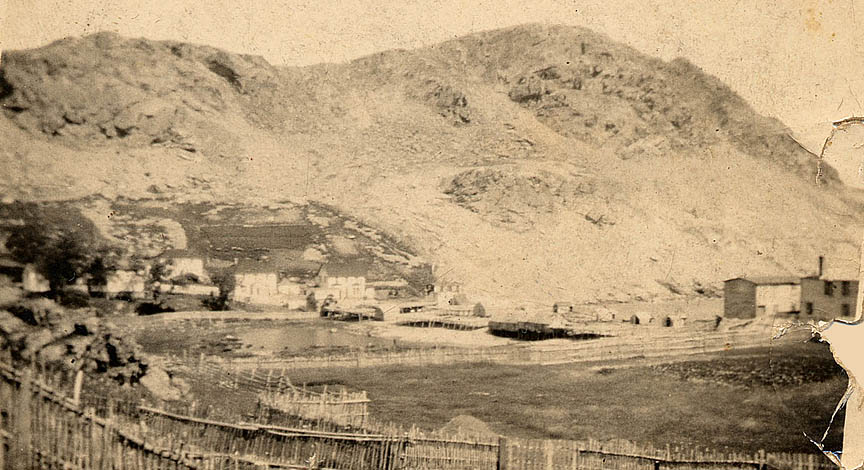 |
|||||||||||||||||
Taken by my great grandmother, Bertha Davis Parsons, the 1929 photo above shows the "tolt rocks" overlooking the cove filled with stages, or wharves with sheds for cleaning, and salting cod fish. Fish were dried on flakes, or slatted frames and stored in sheds. Small breadbox shaped homes, also known as "saltboxes" to Newfoundlanders, stand among long fence lines of cut saplings outlining the property boundaries. Gardens cling to the hillside and stand in the open fenced field.
In the English fashion of "Planting" a colony, the English 1805 Plantation Records (717K PDF) indicate the Parsons had established a large property or plantation on Clown's Cove, located where the homes are on the right in the photo above. The fishing "room" or property dates before 1755 and was owned by a Jno., John Parsons or Johannes. The property was "By deed of gift from his Father." The Davis family owned an adjacent plot of land with the 1850 Eli Davis house. The majority of the homes, stages and even beach in Bertha's photo above were owned by the Pike family who are also listed in the 1805 records.
Just to the west of the Parsons room were a trio of rooms belonging to another family of early arrivals, the Moores. According to the last will and testament of Thomas Moores written on May 22, 1754 he left "unto my Son John Moores All that my Freshwater Plantation" in Conception Bay. Room 948 is listed under a Jno. or John Moores whose room also encompasses the home location of my great, great grandparents William Davis and Jane Moores Davis, one of the many great, great grand daughters of Thomas.
Clown's Cove would have had an overpowering smell of fish, salt and seaweed. Spidery stages built from spruce poles and slats would hang off the rocky coast lines, enduring crashing serf and roaring gales. Families lined at stage tables would split, gut, deftly remove the spine and heads and salt the cod fish as fishermen tossed their catch from a bouncing boat towards the stage with single-tined forks which they called "pews." Livers would be tossed into an odious cask for cod liver oil. Voices would travel across the cove as stories, told in a "r-less" dialect inherited from English ancestors in rural shires would pass rapidly between workers (The accent probably spread to New England and especially the Boston area from Newfoundlanders migrating to the U.S. - just listen to anyone born and raised in Boston - "Pahk the cah in Havahd Yahd"). Salted fish would cure in sheds and eventually be washed and dried on flakes or drying racks or pine boughs in the sun and breeze. The fish would be turned twice a day for about a week and rushed to cover if rain threatened. Cod would be stored and consumed or if there was a surplus, weighed and sold to the village supply merchant, packaged in barrels and shipped off to Europe, the U.S. and South America. When cod were "running plenty" fishermen would work night and day as children would gather the wild blue berries from the hill sides. "Time is fish and fish is money" was once a common saying for Newfoundlanders. Wool-sweatered fisherman in bulky oilskins and boots would ply the coastal waters in dories, skiffs and four and five man long liners, hand-jigging for cod or haul in gill and trap nets from dark waters below. In a humorous and descriptive account from his book, "From the Nart Shore" of a 1915 inshore fishing excursion, longtime Flatrock resident and author, Herbert L. Pottle explains the competitive and delicate intricacies of "trap berths," fishing and loading, or in his case, overloading a boat in the waters near Carbonear Island: "Shore fishing was invariable a short season - a few frantic weeks. It was when I was about eight years old that the date for setting cod traps was changed from 25 May to 5 June. Father used to figure 100 quintals of fish by 12 July (Orangeman’s Day) as a fair catch up to that date. A total "voyage" of 100 quintals per man was considered "a good summer". And a quintal of fish for a barrel of flour was a local equation signifying rough justice.
Securing trap berths was something of a lottery but mostly a loss of sleep, especially in the case of very good berths. What usually happened was that the more powerful crews tended to make a pitch for the choice fishing locations around Carbonear Island well ahead of the trap-setting day - sometimes as much as a week in advance. This meant "lying to" on the berths during the day - anchored as a rule, which was against the law - and huddling up in some inlet of the island at night. Being thus exposed in an open boat for several days and nights, even by shifts, in late May and early June, was an outdoor exercise tantamount to an ordeal.
Our larger cod trap was about 60 fathoms "on the round" (the total length of the four sides, the perimeter) and about 12 fathoms deep. The fish are led into the trap by a "leader" - a straight wall of twine - in such a way that, once the fish are inside, they tend to swim around and around in the same free space. The trap is winched or manually pulled from the bottom by four ropes, and as the twine is drawn up out of the water it is "paid away" (let go again), so that the area of the trap in which the fish are swimming is reduced until they are "dried up" at the surface. In the case of a big haul, once the boat is loaded, the rest of the fish are "bagged off" - that is, they are shifted from the trap into a large knitted, twine bag, then tied to the main trap and let float there until later picked up."
"Down, down settled the boat, inch by inch, quintal by quintal, fish by fish, until the water was lapping the gunwales. Probably some warning word from father or Art that we were going under stayed the overloading hands…
Risky Business Unpredictable weather was the norm as fog, high winds, blizzards and rough seas would roll in at any moment. More than 7,000 wrecks line the coast of Newfoundland. During one weather event in June, 1901, a schooner left Carbonear and was struck by a violent storm causing her to loose her sails. The ship was pushed onto the rocks and tore out the bottom of the ship, flooding the living quarters. Survivors tied themselves to the deck rigging where they awaited their fate. After a night of ill fated rescue attempts in rough seas and a torrential downpour, the calmer morning allowed for the rescue of the nearly storm stripped survivors and unfortunate dead. Just a couple of years earlier, in September of 1899, a hurricane swept over the entire island, drowning many Newfoundlanders, destroying many fishing villages, boats and ships. |
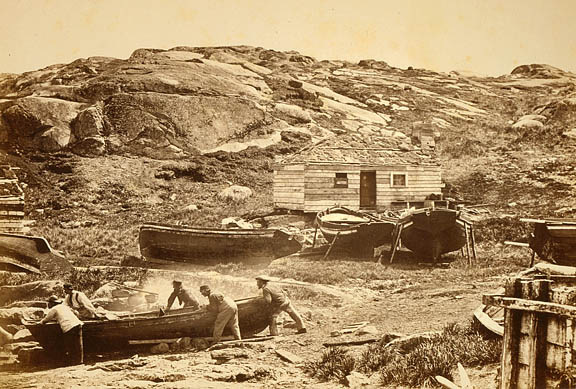 Many Clown's Cove and Freshwater families traveled north to find more fish and set up temporary fishing camps to prepare their catch. In a 1864 Labrador fishing village, the men work with their fishing boat with a pot or "barking kettle" over a smoking fire as a woman in long dress stands in the doorway of the timber and sod house while another family member looks out the window. Library of Congress. |
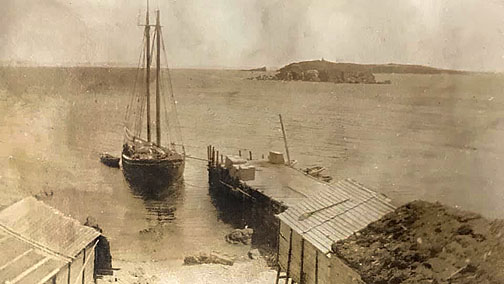 In a rare photo of a ship at Freshwater, the schooner "The Garland" owned by John Parsons and his brother Mark remains docked near the wharf. A plank runs between the ship and wharf, perhaps while unloading fish or loading supplies. The Garland sank in 1927 after a fishing season "down on the Labrador" near Triangle, about 30 miles north of Battle Harbor. The ever present, Maiden and Carbonear islands float in the background as fishing stages with storage sheds stand adjacent to the wharf. Notice the paddle on the roof of one shed and what looks like sod covering the roof of another. (Photo from Parsons relative on Public Facebook group - Freshwater, C.B., Newfoundland) |
| Despite the risks, many European countries fished for cod off the Grand Banks for centuries. The Clown's Cove area became a popular stopping off point for early 1600's sailors in preparing their fish and was labeled on some of the first international maps of the area including one from 1677. The area also had a near by source of fresh water - Freshwater Pond, which was most likely the origin of the town name. Later, a few fisherman stayed and then their families arrived, populating the little area surrounded by rocky hills Newfoundlanders refer to as "tolts." Settlements outside of the original port of St. John's, or "outports," grew as coastal fishing villages became more populated with mainly English settlers, and industrious families built sod houses, fished the local waters, built stages for drying their catch, raised families and worked the land for hay and vegetables. The Parsons were some of those early settlers called "planters" occupying shoreline fishing "rooms" known as "plantations." These "resident boatkeepers" or fishermen, are listed in Sir John Berry's Census of 1675. Joseph Parsons along with his wife, five children, three hired (and paid) fishing workers dubbed "servants," with having 1 boat and 1 stage and living in Clown's Cove. The area grew as Davis families arrived in the area in the early 1700's. An 1800's home still remains as well as many graves at the cemetery close by. The Davis House was built around 1850, likely by George Davis and where Eli Davis resided, my great, great grand uncle. His brother William Davis (1850 - 1937) is my great, great grandfather. Eli's son, John Hayward Davis also lived in the Davis House. The home is similar to the rectangular homes pictured in the 1929 photo and is a Registered Heritage Structure of Canada and has been restored by the current owners and the Newfoundland Historic Trust. Early living for these settlers was difficult as they had to survive the long winters, invading armies and even pirate raids as early as 1614 with minimal resources. Yet, despite the hardships, settlers continued to endure and prosper, supporting each other through hard times. Local families fished rough seas, endured harsh weather, and even rescued passengers from stricken ships. The December 31, 1840 Carbonear Sentinel, reports Clown's Cove residents rescued survivors from the stranded St. Patrick, a "Packet Boat" transferring goods and people to and from Carbonear. The ship had struck the rocks off Maiden Island in a snow storm and was blown onto the rocks off Clown's cove in high seas. In the violent weather, residents at 6 PM, in the dark, heard the cries of survivors and manned a rescue. Locals including Richard Parsons, Richard Davis, Charles Moores, William Pottle, John Butt and others tied a line to the shore and threw the other end to rocks. In rough seas they pulled survivors from the stricken ship, rescuing many of the passengers and crew. Ironically, on the same page of the Sentinel, an advertisement seeks passengers and packages and states that the same St. Patrick had been repaired and is making runs between Carbonear and Portugal Cove again! Snow storms affected more than just shipping. According to Lawrence Coughlan, an appointed deacon by the Bishop of London for Newfoundland in 1766, "The winters in Newfoundland are very severe, there being great falls of snow and hard frost; the Houses there are mostly very disagreeable to those who are not used to them; in general they are all wood, the walls, so called are studs put in the ground close together, and between each, they stop Moss as they call it, to keep out the snow; this they cover Bark of Trees, and put great Clods over that, some are covered with Board in such houses I have been and in the morning my bedside has had a beautiful white covering of snow. My shoes have been hard frozen, that I could not well put them on til brought to the fire." In the bitter winter of 1697 during King William’s War, French forces led by Pierre Le Moyne D’Iberville ravaged and burned settlements on the Avalon Peninsula including Newfoundland's Capitol, St. John’s. About 200 local residents around Carbonear area retreated to Carbonear island and fired upon the French with six pound cannons and refused D’Iberville’s appeal that they surrender. Days later, the French attempted to land on the island but were again repelled. Many more battles occurred and more settlements including Carbonear were burned. However, reports from local residents maintain the French never entered Freshwater as the strategic battery on Freshwater Hill manned with soldiers, a pair of canon and town residents also repelled the invading army. |
|
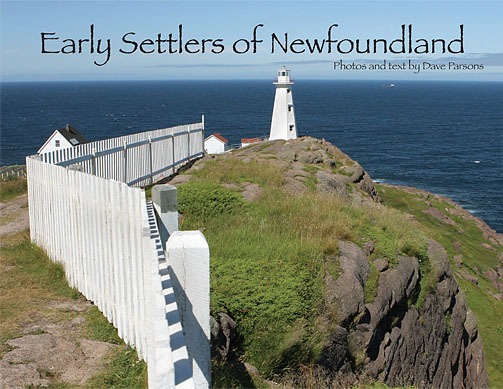 Learn more about the history of Newfoundland in, Early Settlers of Newfoundland written by Dave Parsons. Includes more photographs from my 2006 visit along with a general Newfoundland history. 21 MB PDF |
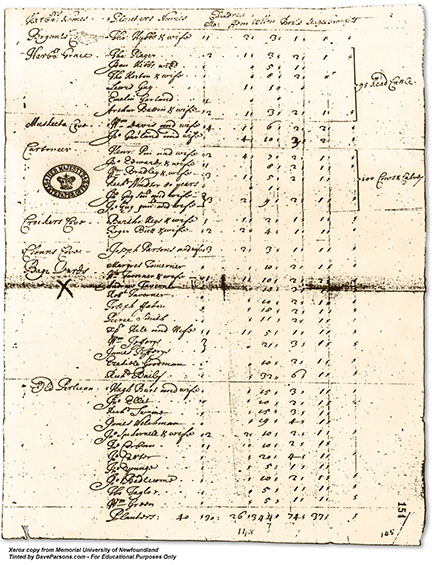 Part of a copied 1675 "In New Found Land: A List of Planter Names..." showing Clown's Cove with Joseph Parsons along with his wife, 3 male and 2 female children, three hired men and having 1 boat and 1 stage. Memorial University of Newfoundland PDF. |
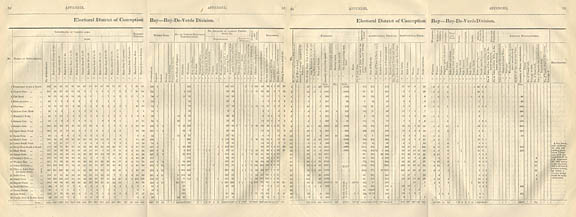 Statistics from the 1858 Journal of the House of Assembly of Newfoundland shows a growing population in the 'Bay de Verde' area including Freshwater and Clown's Cove. Book from the Memorial University of Newfoundland. |
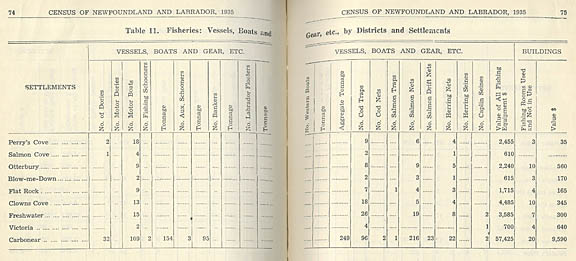 The 1935 Newfoundland Census lists boats and fishing gear from towns around the Freshwater. Census from the Memorial University of Newfoundland. |
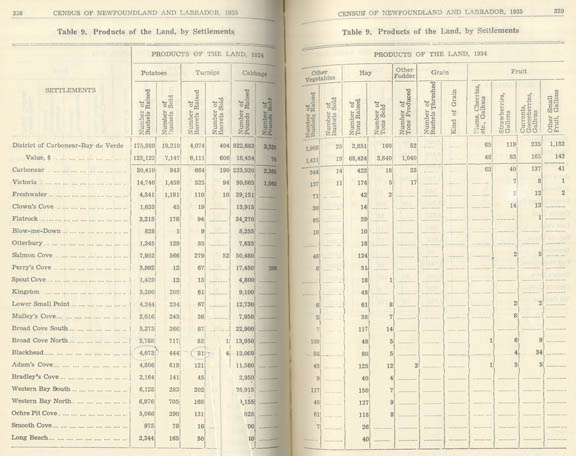 More statistics in the 1935 Newfoundland Census. From the Memorial University of Newfoundland. |
 The 1877 Directory lists Freshwater planters. Directory from the Memorial University of Newfoundland. |
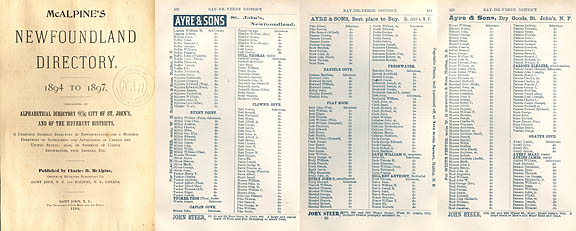
McALPINE'S Newfoundland Directory lists the residents of Clown's Cove and Freshwater/Carbonear from 1894 to 1897. Some residents like Eli Davis (1843 - 1931) are listed in both Clown's Cove and Freshwater. Eli is listed next to a William G. Davis, a carpenter in Freshwater. Nicholas Parsons (1845 - 1905), my great, great grandfather is listed as Freshwater fisherman and perhaps his father Richard Parsons and uncle Joseph Parsons are listed as Freshwater fisherman also. The tough part, if at all possible, is to identify the correct ancestor, as so many of the family names are the same. |
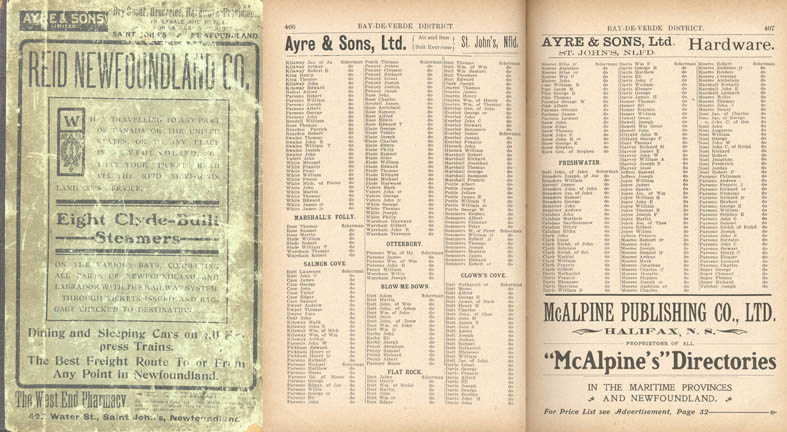 The 1904 Directory lists Clown's Cove and Freshwater fishermen, no longer planters.' Directory from the Memorial University of Newfoundland. |
 A bit of Freshwater history from a 1959 Newfoundland Quarterly magazine. From the Memorial University of Newfoundland. |
  1709 Petition to Queen Anne from Carbonear and nearby residents sheltering at Carbonear Island asking for English support from French attacks. Signed by George Davis, Thomas Moores, Thomas Pike and other locals. Author colorized black and white Queen Anne document scan from David Pike's Family History and Genealogy Resources Page. Book page from Encyclopedia of Newfoundland in the Memorial University of Newfoundland. |
   Freshwater shipping accounting documents from 1753 and 1761. Documents from Family History Society of Newfoundland and Labrador - fhsnl.ca. |
24 November 1828
Joseph Parsons Vs. George Davis - Case worth sum of 4 pounds being for the use and occupation of certain Premises at Freshwater from the 1st June 1820 to October 1828 as per annum.
Dft (Defendant) pleads General Issue
Jury Sworn
 1828 - George Davis Vs Joseph Parsons dispute in Freshwater. Harbor Grace Documents from Family History Society of Newfoundland and Labrador - fhsnl.ca. |
William Parsons (of Jonathan) Freshwater
John Parsons
Robert Parsons (Bears Cove)
William Parsons (of the Plum?)
Jonnthan Parsons
William Parsons (Caplin Cove)
George Parsons (Harbor Grace)
Nathan Payne
John Payne (Harbor Grace)
Nicolas Payne
John Patey
William Penny
Mr Halls For Plaintiff W Anderson for Defendant
Deed Of sale dated 21 October 1806 from George and James Kemph and Co To Joseph Parsons the Pltf (Plaintiff) should forever certain premises at Freshwater with stage flakes took the property of Mr Marshall and others bounded on the W. by Ely (Elizabeth) Anderson -E by the Sea - on the NW by the woods Cons on 60 pounds.
Joseph Suppers Witness: knows Pltf and Dft (defendant) resides at Freshwater and is a Planter - knows stage near Dft Premises - knows the premises lot the property of Mr Marshall which has been occupied by Plaintiff for some years - Pltf and Robert Marshall built the stage together about 18 years ago on the premises described in the deed - Pltf and Marshall occupied the premises and carried out the Fishing together for 2 or 3 years - Pltf had potatoes and cabbages planted on the premises - the stage fell down about 8 years ago after which Pltf built it up - the stage usually gives way come spring with the sea -
Witness thinks the use of the ground where the stage is may be worth five shillings per annum. X knows that Robert Marshall had a brother called Jonathan Marshall (Room #944) who owned a part of the premises occupied by his brother.
 1862 wills of Francis and Samual Jeffers with his "...fishing Room and plantation now in my possesssion situated in Freshwater bounded on the west by Jonathan Moors and on the east by George Davis, on the north by the woods and on the south by the sea..." Wills Volume 2-fhsnl.ca. |
William Moors Witness: lives at Freshwater knows the Pltf and Dft there is only one stage between Pltf and Dft premises - knows that many years ago Pltf purchased some premises from Kemps and Co and that Pltf has occupied them ever since. Witness thinks Pltf has occupied then premises for 20 years - part pf the stage was always considered the boundary - Dft has been fishing on the stage often of at all events for 6 years - the privilege for which the stage is worth 10 shilling a year.
Dft occupies the premises formerly Jonathan Marshalls (Room #944). Pltf has made no fish on the Room for several years. Joseph Parsons — recollects Dft paying Pltf Rent for a stage in 1818 - fit is a son of Pltf. Dft give Pltf one Quintal of Menhan table fish which is that year was 16 shillings. The Rent was paid Dft — Parsons on Pltf amount-
Plaintiffs Case closed
Robert Marshall W: Witness lives in Freshwater - the Western part of old Richard Marshalls Room (Room #945) was willed to witness and his brother Jonathan (who owned Room #944) - the certain part of the room was occupied by Richard Marshall swear William Marshall and Elizabeth Anderson - the Pltf now possessing what was sold by Kemph and Co, then. Dft holds what was Jonnthan’s premises (944).
North? sea washes south? Stage which is annually the wreck is divided and then taken away by Pltf and Witness - Pltf occupied the stage jointly with Witness for some years say five years. Dft still occupies the part of the stage which he purchased from Jonathan Parsons.
Jonathan Marshall Witness: Is son of old Richard Marshall (who owned Room #945) who once occupied the premises now possessed by Pltf (944) about 21 years ago. Witness sold his room to William Davis and which he again sold to Dft. The Rock upon which the stage is built is altogether and the part of the Room and opposite the Premises of John Sewell. Defts Room as some distance from the stage and does not adjoin it - the Rock belongs to the Room sold by Witness to William Davis and now possessed by Dft.
William Davis Witness: Lives in Clowns Cove sold to Dft the premises now possessed by him the rock was included in what Witness sold to Dft the premises now occupied by Pltf belonged to the first wife of Richard Marshall -
Verdict for the Defendant.
  May 29, 1834 Mr. Thomas Parsons builds and launches the 91 ton schooner "Cordelia" from Clown's Cove, much like the ship being rebuilt in Placentia in 1928. Also in the same week another pair of Parsons, Mr. Joseph Parsons of Carbonear and Miss Catherine Parsons of Clown's Cove were married by Rev. J.G. Hennigar. News clipping from Canadian Research Knowledge Network. Photo from Memorial University of Newfoundland. |
Growing Businesses, Families and Organizations
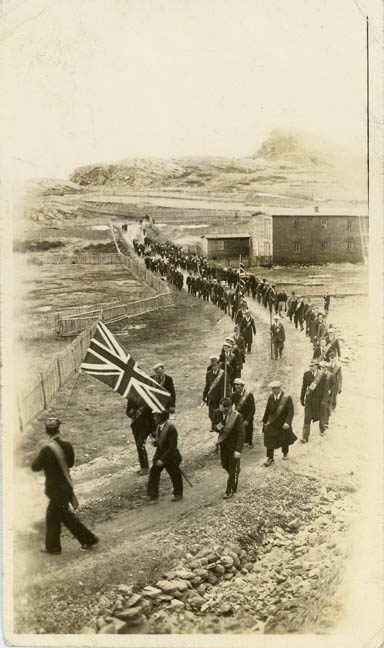 Walking in line, Freshwater's Orange Lodge #62 members wearing their sashes (link pictures sash from nearby Carbonear) walk Flatrock Road above Freshwater, past the buildings owned by Worley Noel. (Photos from Public Facebook groups - Freshwater, C.B., Newfoundland & Carbonear Heritage Society) |
The Freshwater area continued to grow. In 1858, statistics show 145 people living in 21 Clown's Cove houses with 20 acres of 'improved' lands, all born in Newfoundland, mainly catching and curing fish and attending one school and one church. The cove had one horse, four milch cows, nine neat cattle and 29 swine and goats. Families produced over 184 barrels of potatoes and 13 tons of hay. With only two nets and seines, the village had 19 large boats capable of hauling 4 to 15 quintals (a quintal is an old English measure for 112 pounds (51 kilograms) of fish) and three large boats capable of hauling over 30 quintals. They cleaned, dried and processed 1,565 quintals of fish and produced 1600 gallons of fish oil for the year.
As migratory fishing ships from Europe filtered in and out of the area, they brought news and new faces and ideas. As information spread through the growing community, these introduced ideas and organizations or societies also took root. Two that developed early on were the Methodist Church and the Loyal Orange Institution.
The Loyal Orange Institution also known as the Orange Lodge and Orange Order developed as a result of the Protestant Reformation, the Glorious Revolution of 1688 and the never ending battle for religious supremacy between Catholicism and Protestantism.
During the Battle of the Boyne, fought on July 1, 1690 in Ireland, the Catholic Jacobites were defeated as the deposed King James II fled back to France and the Protestant, William of Orange established himself firmly on the English throne as King William III.
The battle, the largest engagement on Irish soil and a defeat for French king Louis XIV, William’s long time foe, was crucial in securing the spread of Anglican Protestantism in Ireland. Significant for Irish Protestants, an organization was later established in 1795 known as the Orange Order derived from William of Orange and was designed to defend Protestantism in Ireland. As a result, the image of William III of riding his white horse with sword drawn and the dates 1688 and 1690 were emblazoned Orange Lodge banners, member vests, medals and printed material along with other fraternal and biblical symbols.
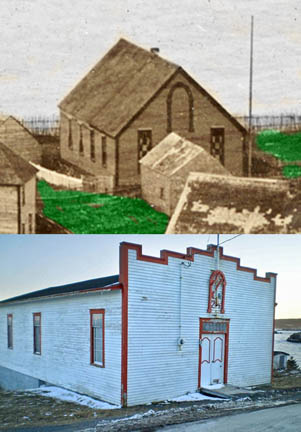 The characteristic twin pillars and archway are depicted on the outside of the Orange Lodge buildings. A flag pole also stands above both buildings. The earlier lodge in the 1900 photo was most likely built in the 1800s (original photo B-4-76 from The Rooms Provincial Archives). The lower photo taken in the 1980s shows the lodge that was built in 1911 near the same location as the first. Residents remember playing darts and having dances there as well as Monday night Lodge meetings. (Public Facebook groups - Freshwater, C.B., Newfoundland). |
That Protestant pride spread from Ireland to the settlements in Newfoundland and Canada in the form of the Loyal Orange Lodge (LOL), a fraternal organization memorializing the efforts of King William III. The "benevolent and friendly society" with their mottos "In God is my Trust" and "Honor all men, love the brotherhood, fear God, and honor the king," formed their Society "for the purpose of assisting each other in time of sickness" according to a 1861 LOL pamphlet.
Also spreading at the time in Freshwater and Conception Bay was the influence of a new Christian denomination, Methodism, a Protestant belief rivaling the Church of England which involved logic and reason "in all matters of faith." The inclusive religion, known for its rich musical tradition, followed the teachings of an British Anglican cleric, John Wesley and was introduced to Newfoundland in 1765 by evangelist Lawrence Coughlan. Initially slow to gain ground, by the mid 1800's, Methodism spread to most of the island which succeeded in establishing an educational system of building schools and combating illiteracy.
Both the Protestant Loyal Orange Lodge and the Methodist Church and schools seemed to grow in tandem with many of the small outports including Freshwater. In the 1900 panoramic photo of Freshwater at the top of the page, the Methodist school stands just a few houses down from the Orange Lodge, with its two pillars and arch over the doors. A later Orange Lodge was constructed in 1911 near the same location on the waters edge. The second Methodist church constructed, the Freshwater United Church was built in 1881 and stood on the high ground overlooking the small fishing village.
After steady gains in late 1880s, the Freshwater population took a hit soon after during a fishery collapse in the 1890s, but began to rise from 1901 into the 1920s. The prosperous times in Freshwater resulted in a larger, third version of the church, one that would be built in 1926 on the same location as the previous church.
 The authors artistic representation of William Davis combining three different people and adding his cane and boulder hat in front of church per Graham Butt's description. |
Today, in Clown's Cove and Freshwater, many of the homes built in the days when cod fishing was booming have disappeared. An open field is all that remains of William Davis' house which overlooked Maiden and Carbonear Islands (my great, great grandfather).
 The "right steep" roof of the William Davis house stands to the right of the rocks with sheds, and a barn. (original photo B-4-76 from The Rooms Provincial Archives). |
According to Graham Butt, a longtime resident describing the old Davis house, "the roof of the house was right steep you know." So steep in fact, according to Davis in his letter in 1931 to his son George, "I got the felt for my house but I can’t get nobody to help me to put it on. I suppose we'll have to try and put it on ourselves. The misses will have to put on pants and get up on the house with me and I tell you it's no load on her to climb on the house although she is seventy."
Graham also remembered Davis’ later wife Flora Pye Davis "the old lady, she used to make molasses hops and sell them to the kids going to school." Graham continued about William: "Oh, I remember him, he was a tall, tall straight man and he'd always walk with a cane you know and he'd go to church and he'd have that boulder hat on you know." (boulder hat - looked like a upside down bowl with a rim on it). "And he’d used to talk in a right loud voice. His brother used to live over there (pointing to the Eli Davis House) - with John Hayward’s father - Eli and his brother George" (see the video below).
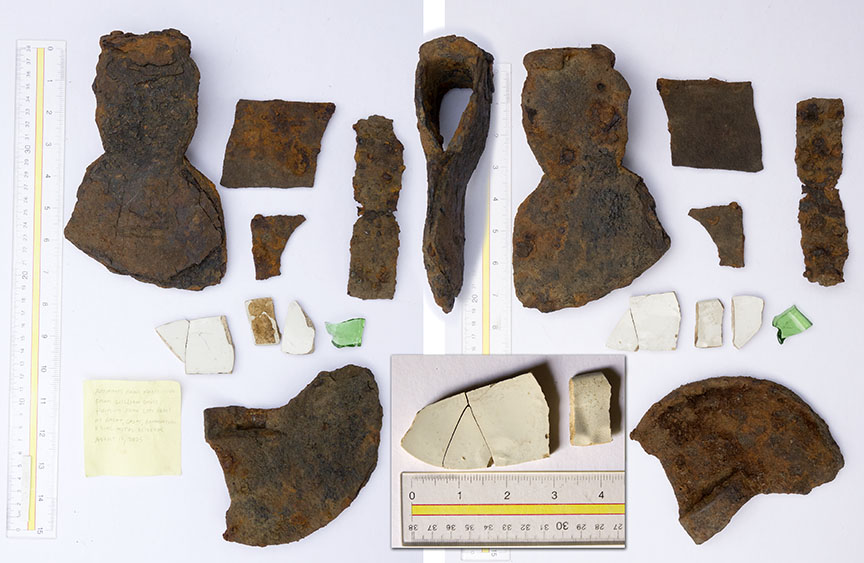 With permission from an adjacent property owner, I used a metal detector in a ten foot square area in the tall grass and found a few artifacts including an axe head, cast iron pot lit and dish fragments 6 inches beneath the surface top soil on William Davis' old property in Freshwater, Newfoundland on August 13, 2025. The recent shard of green coke bottle was found only a couple of inches below the surface. The area was located near the fenceline corner near where the Davis storage shed and home once stood (1900 photo) and was pointed out in 2006 by Graham Butt and pictured in the open lot photograph below. On August 13, 2025 the plot was completely overgrown with trees and shrubs. The axe is an earlier form with notches in the sides and not straight sides and likely dates from the late 1800s to early 1900s. However, there are similar axes from the 17th and 18th centuries from archaeological sites around the Avalon Peninsula. Finding the axe head and dish fragments just feet from the homesite of William Davis and his first wife Jane Moores makes me think of the possibilities they once cut firewood with the old axe and used the dishes at meals for years. |
 Another view of the Davis family property with the Clown's Cove tolt in the distance in 2006. (Dave Parsons photos stitched together) |
 July 21, 2006 - Standing on the edge of Parsons Lane with the Clown's Cove face and tolt in the distance as well as the road leading to Flatrock. (Dave Parsons photos stitched together) |
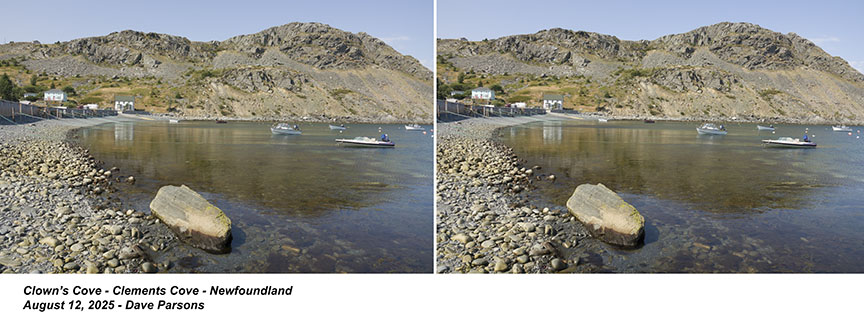 Stereoview photos of Clown's Cove tolt and Clements Cove motorboats today during a calm day. (Dave Parsons photos) |
 Early stereoview looking over the homes and few small boats in Freshwater Bay. One of the few, stereoviews of Freshwater - and the 3D works! The photographer or likely the wind shook the camera on the tripod and the image is a bit blurred. A professional photographer took photos in the small communities within what is now referred to as Conception Bay North, like Western Bay, Tackers Cove and Small Point-Adam’s Cove-Blackhead-Broad Cove. However, there is at least one view of Freshwater, Carbonear and St. Johns. Stereoview photography was rare and expensive in Newfoundland at the time. It was likely Frederick Stevenson, once an employee of the Underwood and Underwood stereoview company until 1902 and now United Methodist Church Secretary overseeing foreign youth missions was documenting the works of the church among life in small Newfoundland outport villages. This included the missionary travels of Reverend, Charles Lench (pictured below) who was also writing his book titled "The History and Rise and progress of Methodism on the Western Bay Circuit…" published in 1912. See the other stereoviews and watch the CBC videos - October 15, 2024 CBC article and video and January 11, 2025 CBC follow up story.  |
 |
"Those fishermen - some went to the U.S. to work in the summer, usually in construction. My father was a fisherman and a miner who went to Nova Scotia if he didn't get a good year fishing. Many people did that and went away in the fall mining and came back for the next fishing season... My father was doing that even before I was born and a lot of others from neighboring communities - it was a backup for fishing. In 1935 there was a big storm in August - most of the boats came ashore and broke up and that was the end of the inshore fishery in Freshwater and Flatrock." (Memorial University of Newfoundland)
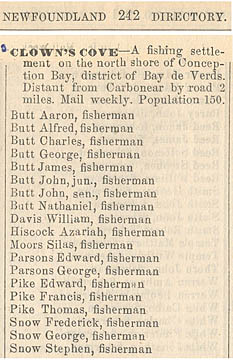 The Davis and Parsons family members are listed in the Lovell's 1871 Newfoundland Directory. Directory from the Memorial Univ. of Newfoundland |
Unfortunately, as overfishing became more common, the busy fishing village of Clown's Cove, once with a long wharf and stages for drying cod fish began to suffer hard Depression years. For William and Flora who stayed behind in Clown's Cove, just surviving was a challenge. On May 26, 1931, William wrote to his son George:
"Sorry to hear the times are so bad in the States and that you have done nothing since Xmas but let it be never so bad in the States it’s not as bad as it is in NFLD for there’s hundreds and thousands don’t know what they’re going to do this summer. The whole country is in a confusion and don’t know what’s going to be the end of it...
The weather is getting fine here now the summer is come but the fish and salmon are very scarce. I tell you there’s not many stages built on Clown’s Cove this summer. The capelin will have lots of room to run ashore this summer. Uncle Eli and Uncle George is not much of it neither one of them. John Hayward is home walking about don’t know that he’s going to do this summer and hundreds more like him."
 William Davis original letter from May 26, 1931 describing the Depression and lack of work and trying to put the felt on his house. Parsons Collection |
"Well, George, my boy, I received your letter on Saturday and more than thankful to you for the present that you sent to me and thanks to you very much for it for it came in a very good time to get a barrel of flour as our flour is just about out now and it is getting fine and cheap. 5.20 a barrel as we haven’t had one since October and this is May so I don’t think that we have anything to grumble at in regards of extravagances in flour."
 William Davis original letter from May 20, 1931 thanking his son and describing the fire in nearby Carbonear. Parsons Collection |
"I must tell you that first night there was a terrible fire in Carbonear. There was 14 homes destroyed in all and Billy Mores place that was Mr. Duffs big brick building was burnt flat to the ground. You know that he sold it last year to Mr. William Mores from Freshwater and all of Saunders and Howell’s factory and the boot and shoe factory and Maddock’s place and Leonard Ash’s and all the lumber yard there was pieces of paper and felt came down here and pitched in our garden. So that is all of that now I must tell you that I am tired tonight for I was working hard today in the garden clearing away and working out the ground to set our few potatoes in and the misses is cutting the seed to begin tomorrow or next day. You know that it don’t take much to make me tired now as I will soon be 81 years old and Mrs. Davis will be 70 the 8th of August so you see that we are not young but thank god we are both gifted with health and strength..."
As malnutrition and poverty spread throughout the island, most Newfoundlanders were barely surviving on inadequate relief payments and a food assistance program known as the "dole" (PDF). In 1935, William and Flora were sick for weeks and his nephews couldn't take them in. So Flora's son, Frederick Pye, from the town of Victoria, just to the north of Freshwater took them in. The Pye family nursed them back to health.
William Davis lived to be 87 years old, and died in bed in his Freshwater home in 1937. Sophia Davis wrote to Bertha Davis Parsons about her father stating she was with him "till the last" and "if you and I make such good ending like your father we will be all right."
Similarly, as many of the older generations died off and over exploitation of the cod fishery became more common, younger generations looked for different opportunities in the cities and abroad.
Likewise the population of the Freshwater area seems to follow the boom and bust cycle of the cod fishery with the population peaking before the 1930s Depression and then declining afterwards.
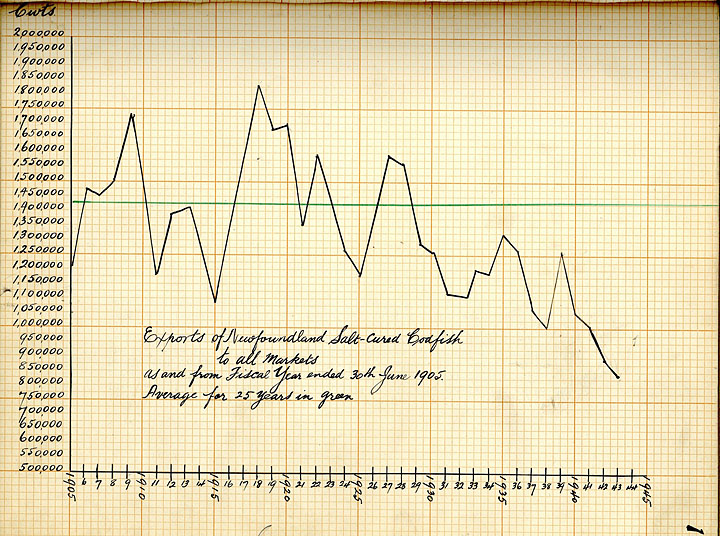 As cod exports declined through boom and busts, so did the population trends of Freshwater, declining through the 1930s. (Maritime History Archive - Public Facebook Page) |
Freshwater was one of the earliest settlements in Conception bay and early on had a population of 22 in 1696 according to Abbe Jean Baudoin’s journal (accompanied le Boyne d’Iberville in 1696-7 French raids). The following census data shows some fluctuations, but the population rises for Freshwater from 1901 to 1921 and is then followed by a heavy decline after the 1930s into the 1940s with a slight rise in the 50s and then steep decline leading to the 1990s. Clown's Cove data suggests the same trends.
 1836 hand written Census of Conception Bay, Newfoundland with Freshwater and Clown's Cove counted together. (Records from Memorial University of Newfoundland). |
First official NFLD census in 1836 for Freshwater and Clown’s Cove - 471 residents - (with 80 dwelling houses)
1845 Census - Freshwater, Clown’s Cove and Otterburry - 575
1857 Census - Freshwater* 322 - Clown's Cove - 145
1869 Census - Freshwater* 392 - Clown's Cove - 153
1874 Census - Freshwater* 464 - Clown's Cove - 172
1891 Census - Freshwater 573 - Clown's Cove 199
1901 Census - Freshwater 534 - Clown's Cove 216
1911 Census - Freshwater 565 - Clown's Cove 177
1921 Census - Freshwater 566 - Clown's Cove 235
1935 Census - Freshwater 372 - Clown's Cove 174
1945 Census - Freshwater 311 - Clown's Cove 151
1951 Census - Freshwater 376
1956 Census - Freshwater 434
1971 Census - Freshwater 147
1976 Census - Freshwater, Clown’s Cove and Otterburry - 242
1981 Census - Freshwater 209
(*Freshwater North and South)
Fishing collapses occurred throughout the 1970's, 80's and 90's, caused by improvements in technology and massive foreign trawlers fishing year-round. The final death knell for fishing in Freshwater and Newfoundland was the was the federal moratorium on cod in 1992 (PDF). A way of life that had endured generations ended as 30,000 people were put out of work. Fishing equipment and boats were sold and much of the outport population that had not moved in the 1950's 60's and 70's centralization (PDF) and resettlement programs (PDF) moved towards the larger towns once again and Clown's Cove turned into more of a small suburb of city of Carbonear.
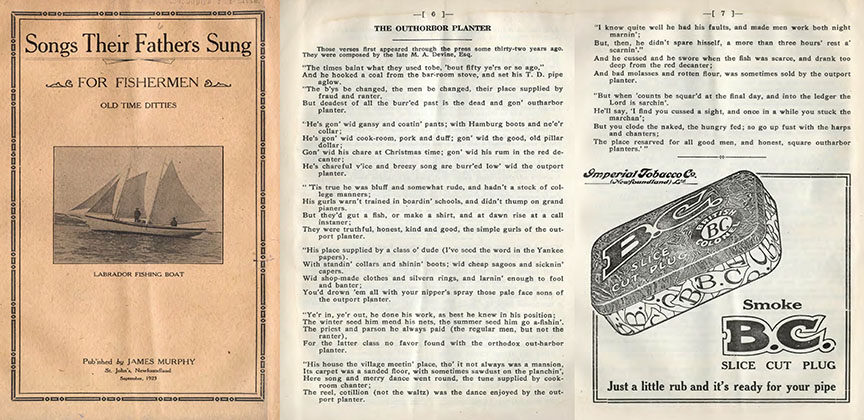 An "old time ditty" written about 1890 for fisherman reminiscing about the out harbor or outport planters from long ago. From the 1923 book in Memorial University of Newfoundland |
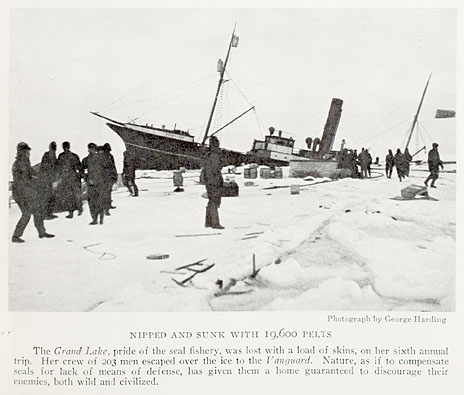 Out on the front, descending through the ice, the steam ship Grand Lake takes her load of seal pelts down to the depths. (July, 1929 National Geographic Magazine) |
Icy Gambling - Newfoundland Sealing
While repairing nets and boats during down time in the winter, many men in the Freshwater Carbonear area would try and earn a bit of money and take part in the annual harp seal hunt.
The second most valuable fishery in Newfoundland, the annual seal hunt started in early March, "the worst time of the year, when gales of wind and snow are the usual thing" according to the famous sealing Captain, Robert Bartlet in 1929.
In the early 1800s, companies owning wooden sailing schooners looking to profit would sometimes purchase old and run down fishing ships from Europe and retrofit them for the ice hunt. They would hire local men for the hunt, who would try and find comfort in the storage hold of a barely seaworthy ship with no bunks, using only their clothes bag for a pillow.
In 1828, sixty ships from Carbonear, five from Freshwater, and one from Clown's Cove made up part of the Newfoundland sealing fleet with a total of 3,180 men from the Conception Bay Area, an early adopting region of the seal fishery. One of those Conception Bay residents, an early innovator, Richard Taylor of Carbonear, was known as "The Thoughtful Man" and worked to protect ships from the crushing ice by fitting wooden bows with "iron sheathing" and strengthened ship hulls with "false beams." He also divided the ships hold into "pounds" for preserving pelts and preventing shifting loads during prolonged voyages.
As ships and technology improved, steam ships were introduced in 1862 and were first made of wood and then steel. Both would be employed in the sealing industry. Steaming out of the harbor in the capitol city of St. John’s as well as outports like Harbor Grace and Carbonear, they would set off to cheering crowds along the wharf along with cannon fire, ringing bells and family well wishers praying for a quick and safe return. Despite such send-offs, the yearly event was brutal on both men and marine mammals as sealing was notoriously dangerous for Newfoundlander's, risking their lives out on the ice and on the ship to the benefit of mainly, the company.
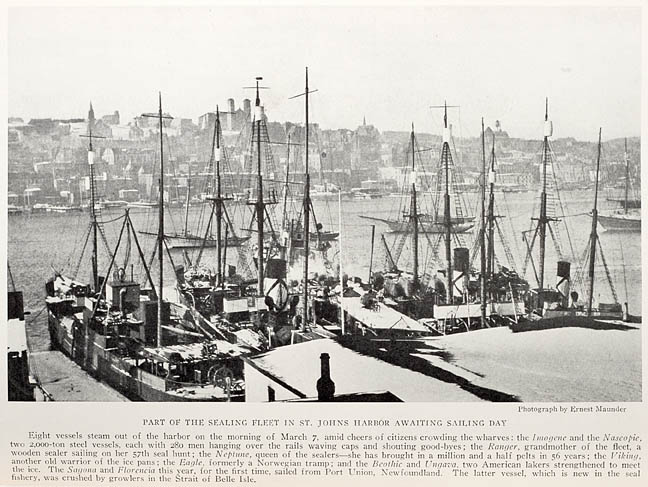  In a sea of masts, the St. John's sealing fleet is ready to steam out of the harbor. (July, 1929 National Geographic Magazine) Hand drawn, a detailed map from 1937 shows the precise route of the Imogene, a sealing vessel traveling north from St. John's and wandering through the ice filled waters in search of pelts. The comprehensive report is compiled by the Bowring Brothers and accounts their sealing journey with daily entries of stowaways, difficult ice, seal locations, telegrams and news reports. (Memorial University of Newfoundland) |
Leaving safe harbors, the sealing fleet would break through the ice flows from their various ports to their northern destinations, many times using dynamite to blow a passage through the ice. Even unfortunate powder explosions and fires occasionally occurred sinking a vessel. Battering winter storms and shifting loads could also sink a ship while sickness could rapidly spread throughout a crew.
If men survived the ship, they faced death on the ice while killing seals from numerous hazards. In freezing conditions, thick fog would set in and blizzards and high winds would rage for days. Other threats were constant, such as falling through the ice and drowning, frost bite, snow blindness and death from exposure as well as being lost and left behind, all for a few dollars of income. According to longtime sealing captain Bartlet, a national hero, "The chance of losing his men on the ice in a fog or blizzard is a worry that always besets a captain."
Furthermore, dangers to the fleet were ever present. Entire ships were sunk with their entire crew and thousands of pelts. Ships propellers would regularly be crushed by ice. Captain Bartlet describes "Scarcely a year went by but one or two ships were lost. The building of steel vessels and the use of wireless to receive weather reports have cut down losses in recent years." (Nat. Geo 1929 pg. 129) He continued to describe the peril:
 Captains and ships from the 1914 sealing disaster with the loss of 77 men. (Photo from Maritime History Archive - Public Facebook Page) |
"In 1914 the fleet was all together on the front. The weather of threatening, but some captains put their men overboard, hoping that the day would end fine. But out of the northwest came a terrific blizzard. Wind and snow jammed the ships, so that they could not get to their men. Lakes of water opened between the men and vessels. In the raging storm many men fell through the cracks and froze. When the weather cleared next day the steamship Newfoundland had lost 77 men!"
For another unfortunate crew, "After making a quick pick-up of seals, the Southern Cross was almost home. Ten hours more and her crew and cargo would have been safe in St. Johns. Off Cape Pine, early in the morning, she was caught in a gale and sank with 174 men. Except for one life belt picked up on the coast of Scotland some months afterward, not even a stray bit of wreckage was ever found."
Much of the sealing process was both reckless and wasteful for both human and animal life. Hunters would strip just the seal hides off young "white coats" (pups 3-4 weeks old) and the older seals protecting the young. There was almost no market for the meat, so seal carcasses were normally left to rot on the ice. If the hide made it back to port without sinking off ice flows or spoiling in the ships hold, the fat on the hide would be rendered for lubricating oil and later and soap production. The pelts would be used for products like sealskin pocketbooks for the American market.
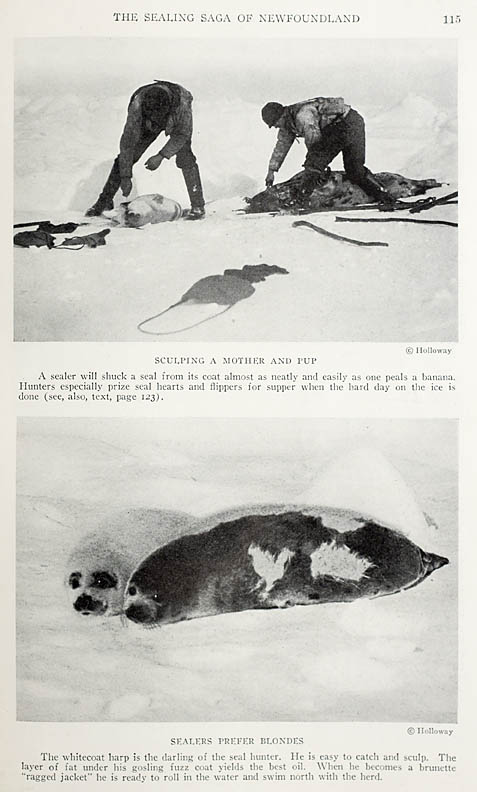 Sealers remove the skins. (July, 1929 National Geographic Magazine) |
The seal fishery was viewed as another source to be extracted, like fish and a way to make money. Narrow viewpoints from fishermen also blamed the seals for consuming too much cod fish, when in reality, humans were and still are depleting the fish stocks through relentless over fishing. Today's veterinarians rule the seal hunt is inherently inhumane and clubbing and shooting of seals in the seal hunt fails to comply with Canada's basic animal welfare standards. Disturbingly, veterinarians found that in 42 percent of the cases they studied, there was not enough evidence of cranial injury to even guarantee unconsciousness at the time of skinning.
The toll on marine wildlife was extensive as millions of harp seals were killed for soap and sealskin products. During the peak of the Newfoundland industry in the 1850s, over 400 sailing vessels and 13,000 men worked the ice producing massive catches of 700,000 seals in one year. Sealing was not limited to Newfoundlanders, as Americans, Norwegians, Scottish, Icelanders, and much of Europe and Asia took part in the hunt below the Arctic Circle.
Outports across the Avalon Peninsula would embrace the industry and produce ships and crews for the sealing industry. Companies such as Bowring Brothers, Job Brothers & Co., Ridley & Sons, and John Rorke would build or supply ships. Men would converge on the home port, signing up as part of the sealing crew for an initial "crop" or advance. In 1929, the advance in St. John’s was $9, to be spent on supplies at the start of their journey or sent back to the family.
 Sealing ships and captains from the 1865-6 season listed in Murphy's Old Carbonear From Memorial University of Newfoundland) |
Many Davis, Moores, Pike and Parsons captained sealing vessels and undoubtedly crewed the fleet. "Only the keenly alert and active" would "qualify as hunters" as "A man snogging seals has to be light-footed, running and jumping over the ice like a deer. A big fellow with broad shoulder has to be followed around with a life belt; he will be falling into the water all the time."
Each sealer received a ticket with his number and name on it along with his advance to be repaid if seals were brought in (in 1929, a higher $12 repayment was required). Captain Bartlett describes the risky results of a hunt as potentially "grave" with small profits for the crew. "The only guarantee a sealer gets is food and a crop note, equivalent to $9. He works on shares. One-third of the net earnings is divided among the crew. That includes everybody except the captain, who gets four percent. He takes the same risk as the crew - no seals, no money." Earlier in the sealing industry, individual hunters had to pay for access for a spot on the ship.
In 1929, "Shares have run as high as $238, but the average is about $60. This is not much, but it comes at a time of the year when a little money looks good." The other two-thirds went to ship expenses and the company investors who risked only capitol, not life and limb. Most sealers knew the pay was minimal, but enjoyed the risk and adventure despite the hardship.
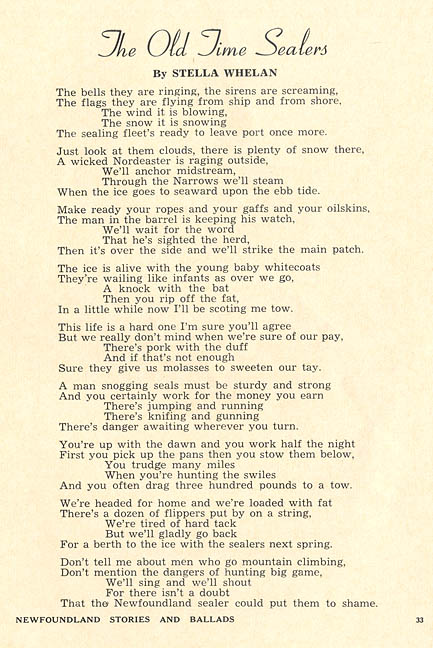 1965 Sealing poem. (Memorial University of Newfoundland) |
Nevertheless, during a 1902 sealing strike in St. John's, workers forced better wages and removed some lodging expenses, but the job was still a gamble. Despite the dangers, plenty of men, even those who narrowly escaped death in icy ship wrecks, quickly signed up for another year of sealing. Likewise, the Summer, 1914 Newfoundland Quarterly states: "The prosecution of the seal fishery off the coasts has always been and will continue to be, so long as it is carried on as at present, a highly dangerous and exciting occupation, those engaged therein being perpetually exposed to disaster and death under conditions and circumstances that would intimidate any men less daring than the hardy and intrepid sons of Newfoundland."
Native populations hunted seals for thousands of years on a small scale using nets and traps. Later, early voyagers and fishermen wrote of harvesting seals through the 1500s and 1600s. As the southward seal migration onto the ice flows was discovered, it was immediately over exploited with numerous collapses where a seal wasn’t seen for years. As technology advanced with stronger steel ships and the use of spotter planes and then helicopters, the numbers of seals declined, just like during the collapse in the cod fishery despite the lowering of seal quotas throughout the years.
Today, the hunt is largely subsidized by the Canadian and Norwegian governments with one Norwegian company purchasing close to 80% of the seal skins from Canada which it uses to produce fashion garments for export. The benefit to Newfoundlanders is minimal as the hunt accounts for less than 1 percent of Newfoundland’s economy. Canadian taxpayers, including Newfoundlanders pay millions of dollars a year for icebreakers to rescue sealing crews by the Canadian Coast Guard. Furthermore, scientists have sounded the alarm regarding the poor science used by the Canadian government to set quotas for the number of seals killed.
Historically, the sealing industry served to help the Newfoundland people despite the cost of lives to its people and wildlife. Today, the subsidized sealing industry now mainly benefits international companies and continues to deplete the Newfoundland taxpayer of hard earned funds and their waters of its wildlife. As seal numbers decline, alternatives to the seal hunt are starting to be being implemented.
One alternative with potential, is marine ecotourism, including seal watching. Viewing visitors with binoculars and clicking cameras could provide a wide distribution of income for Newfoundlanders, from guides, to boats, lodging, meals and food to expanding trips across the island. In the Magdalen Islands, one of Canada’s sealing areas, seal watching now brings in more money to local communities than seal hunting does.
Time will tell if changes can be made to the benefit of both the people and wildlife of Newfoundland.
 1900 view of Freshwater, Clown's Cove and Flatrock in the distace with tolt rocks and numerous punt rowboats in Freshwater Cove. Many more stages hang off the cliffs near the wharf and school in the 1900 photo than in the 1950s photo below. (Author added color and text to original landscape photo by Robert Holloway (1850 - 1904) from The Rooms Provincial Archives - photo F 54-5) |
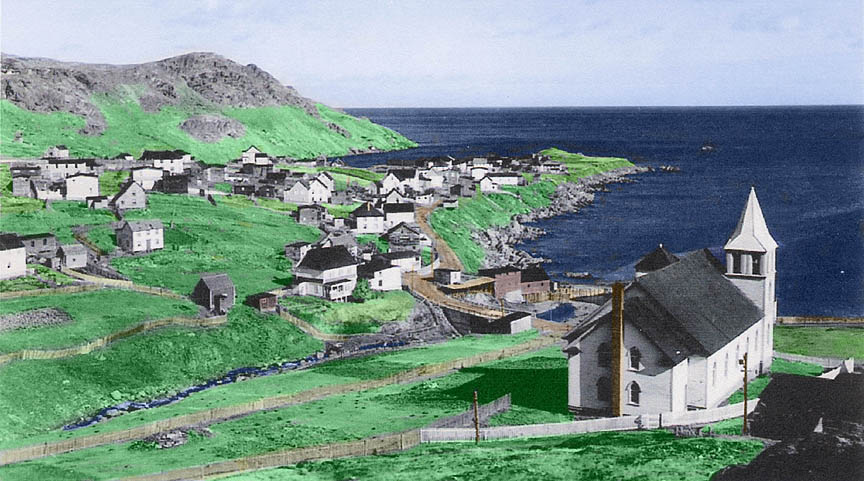 Taken about 1950 from above the Freshwater United Church (3rd version built in 1926), a pair of tall, fish storehouses stand on the wharf and numerous homes line the edge of the cliffs. However, compared to the earlier photos, there are none of the stages lining the cliffs and there are now grassy gaps where homes once stood. Telephone poles poke out behind the church and a cement bridge installed in the late 1940s replaces the old wooden one. The photo was used in the December, 1958 Newfoundland Quarterly (Added color to personal post card) Magazine from the Memorial University of Newfoundland. |
The name of the Clown's Cove area today is often referred to as Clements Cove or Freshwater/Carbonear, the larger populated area lying to the southwest along with a source of fresh water, Freshwater Pond, probably an early source for drinking water close to Clown's Cove and the coast. The map names through the centuries have changed and reappeared depending on what map and what language has been used which makes for chasing ancestors a bit confusing. Despite the area being a few miles in length, it can be referred to by many names like, Clouns Cove, Clown's Cove, Port de Claune, Crockers Cove, Freshwater, Carbonear, Carboniere or Freshwater/Carbonear.
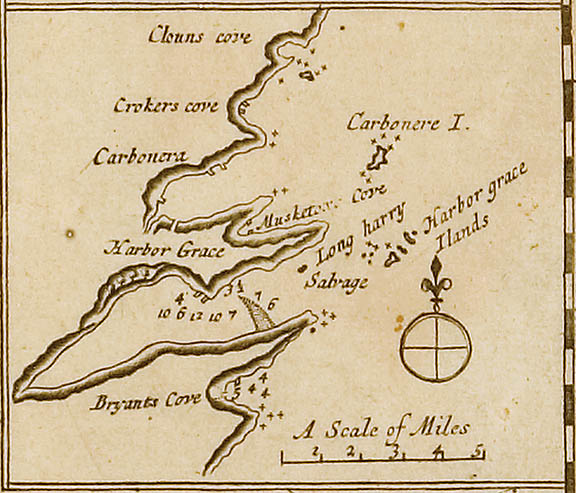 Part of an early 1698 map with 'Clouns cove' or today's Clown's Cove. Crockers cove and 'Carbonera' or Carbonear are a mapped a few miles southwest. Map from Memorial University of Newfoundland. |
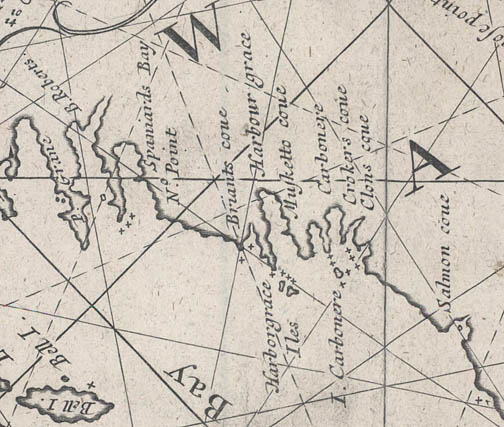 Drawn at an odd angle with north to the right, part of an early 1675 map has 'Clons Cove' identifed. Map from Memorial University of Newfoundland. |
 The top of a 1780 map has labeled 'Clouns Cove for Boats' and no labels for Freshwater or Carbonear. It has also labeled the best route past Carbonaire Island or I Carbonera. Map from Memorial University of Newfoundland. |
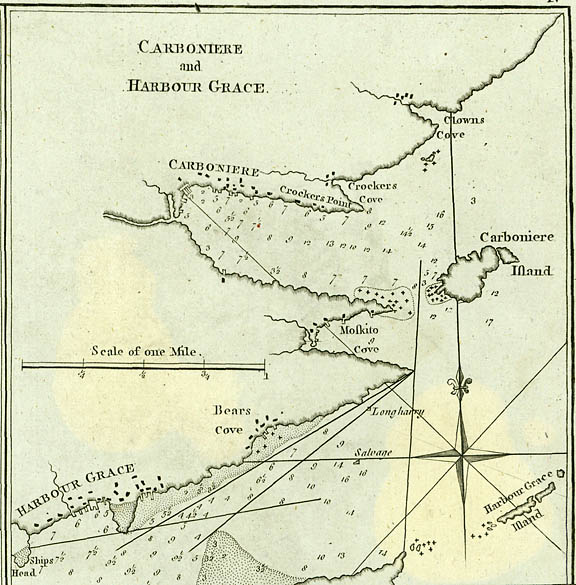 Much more detailed, a squared off portion of a 1770-9 map shows small squares for buildings in Clowns Cove and nearby towns. Map from Memorial University of Newfoundland. |
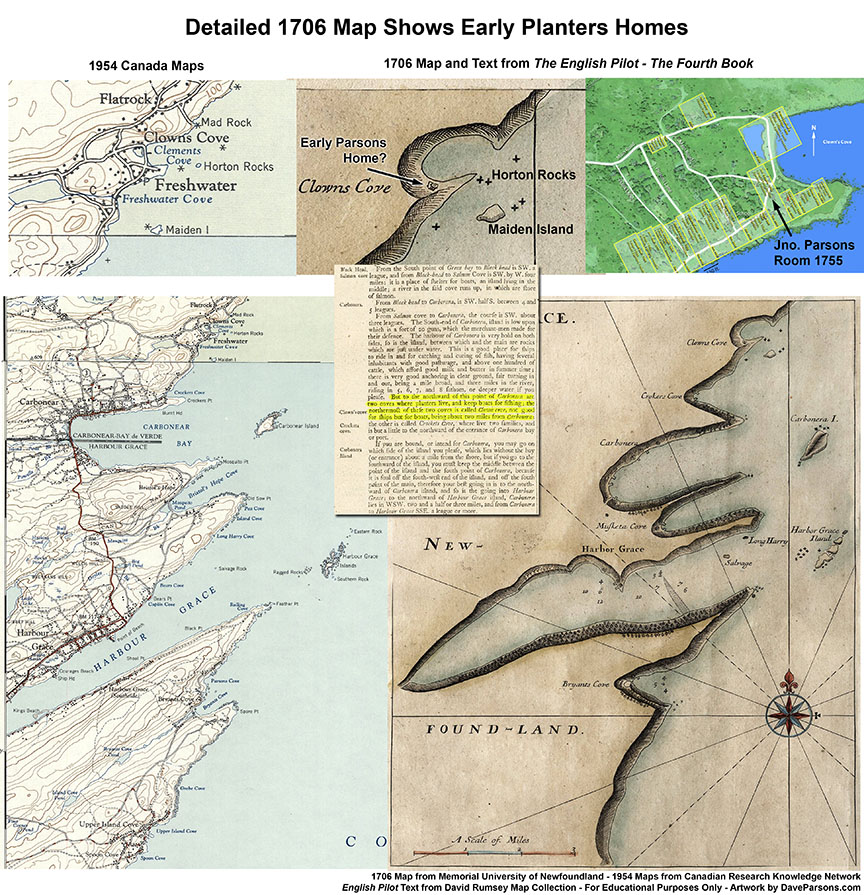 Descriptions of the Clown's Cove and Carbonear Island from the 1706 book, The English Pilot (Later versions of text are slightly different including the 1794 text in the above photo): "Salmon-Cove to Carbonera (the Course is S.W. about 3 Leagues). The S. end of Carbonera Island is low, upon which is a Bulwark of 20 Guns, which the Merchant Men made for their Defense. The Harbor of Carbonera is very bold on both sides, so is the Island, between which and the Main are Rocks, which are just under Water. This is a good place for ships to Ride in, and for catching and curing of Fish; and several Inhabitants with good Pastorage and above 100 Head of Cattle, which afford good Milk and Butter in the Summer-time; there is very good Anchoring in clear Ground, fair turning in or out, being a Mile broad, and 3 Miles into the River, Riding in 5, 6, 7, 8 fathom or deeper Water if you please. But to the Northernmost of these 2 Coves is called Clownes-Cove, not for ships, but good for Boats, being above 2 Miles from Carbonera; the other is called Crockers-Cove, where live two Families, is but a little to the Northward of the entrance of Carbonera (Bay or) Port." Sir Johns Berry's Census of 1675 had one planter family, Joseph Parsons at Clown's Cove and two, Roger Butt and Bartho Keys families at the nearby Crocker's Cove. Similarly, the three houses are shown on the 1706 map with corresponding text which was likely acquired from earlier voyages in the late 1600s. The, piers and points, rocks and islands of Carbonear and Harbor Grace also match the geography of later maps. The 1706 map seems to be an early snapshot back in time showing the location of many of the early settlers or planters in the area. 1954 Maps from Canadian Research Knowledge Network - 1706 map from Memorial University of Newfoundland - English Pilot 1794 Text from the David Ramsey Map Collection. |
 Report from Government of Newfoundland and Labrador. |
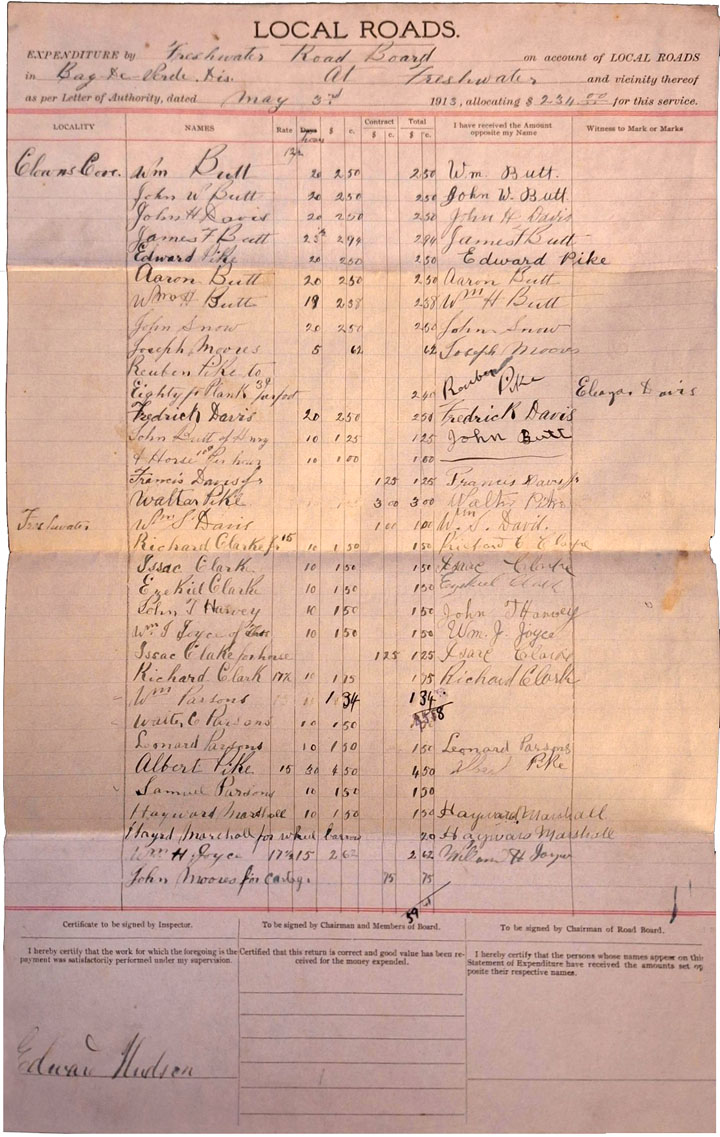 A rare snapshot listing some of the hard working residents in Freshwater and Clown's Cove during May of 1913 performing road maintenance to the Freshwater and Plank Roads (80 Feet Plank 3 cents per foot - total $2.40). Dirt roads needed constant maintenance, especially after the winter or wet seasons when muddy ruts would form. See original photo. From public Facebook group Freshwater, C.B., Newfoundland |
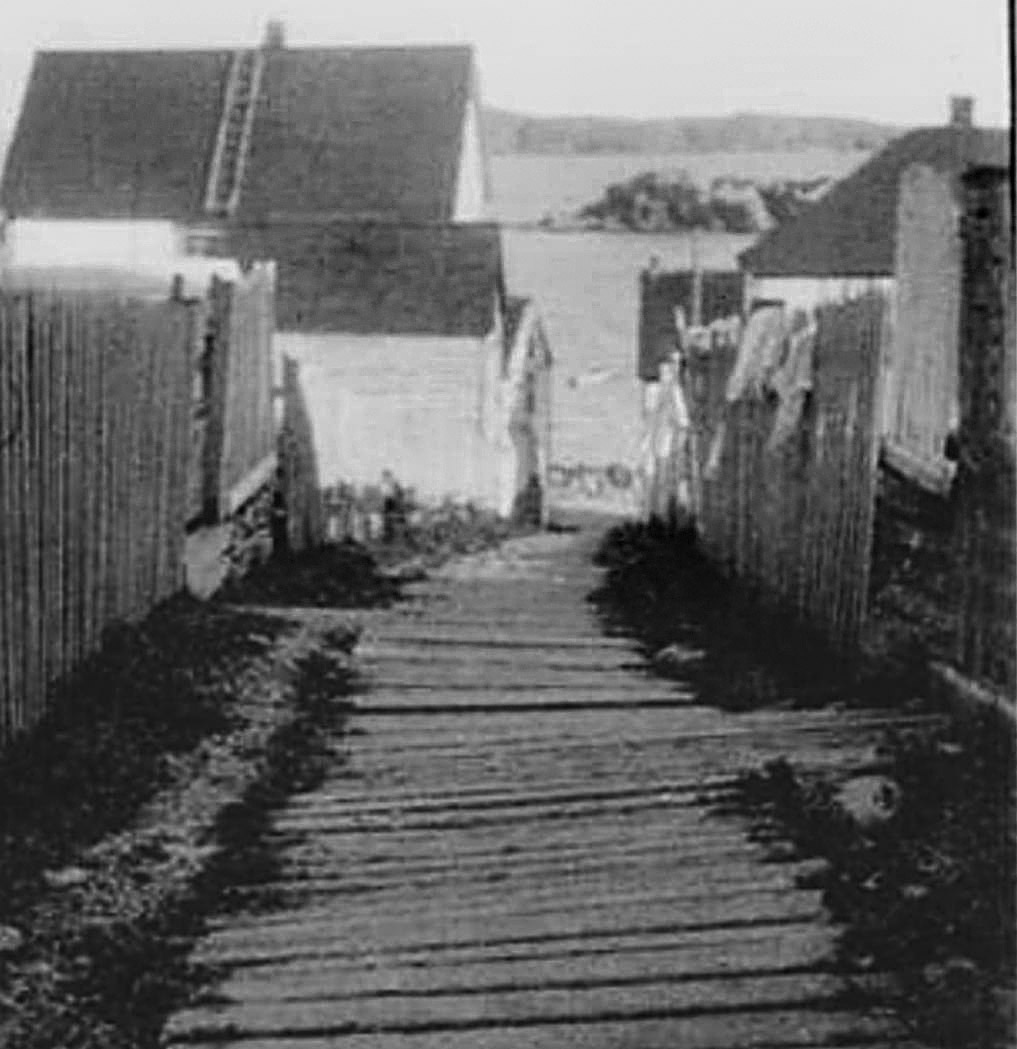 The photo taken in 1924 shows Plank Lane. George and William Davis installed planks on their property over the creek bed which also passed between the Hayward Marshall and Hubert Davis homes in Freshwater. The narrow avenue, just west of Parsons Lane, rolls out towards Freshwater Cove, Maiden and Carbonear Islands. According to locals, residents would haul their wooden fishing boats down over the planks. The wooden roadway was constructed at least by 1913 with listed expenditures showing 80 feet of plank. (Photo from Charles Davis via public Facebook group Freshwater, C.B., Newfoundland) Color version by author. |
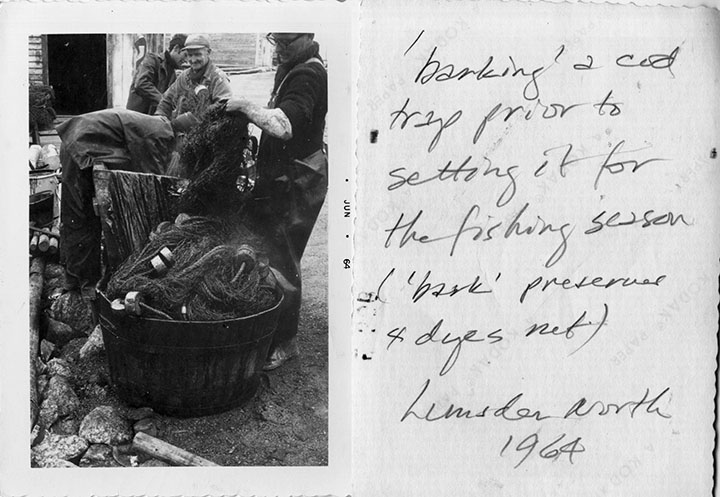 Fisherman living north of Conception Bay "barking" their cod trap net at Lumsden North in 1964. Photo from Memorial University of Newfoundland |
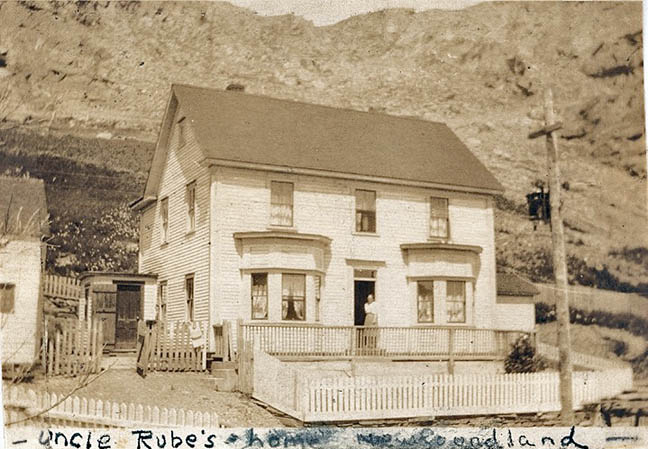 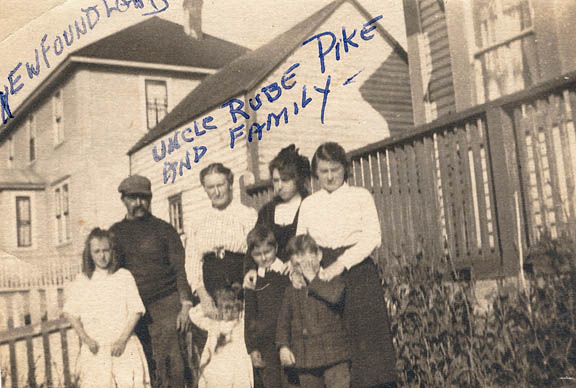 Standing under the Clown's Cove Tolt, the Reuben Pike family home pictured in the 1940s still stands today overlooking the beaches and once busy cove. The Pike family owned much of the land in Clown's Cove and had many codfish stages, flakes and storage buildings as well as a cod liver oil business well into the 1920s. According to the 1805 Plantation Records, Francis, Samuel and Edward Pike owned Room #954 with two houses, two gardens, two meadows as well as one beach with one stage, and two flakes in 1800. The two homes would also multiply onto the tolt as more Freshwater families would marry into the Pike family expanding their fish empire. Unfortunately, the depression and the numerous fish collapses took their toll on the entire area including the Pike family, resulting in a clearing of almost the entire cove of stages and fish preparation. (Photos from Public Facebook group - Freshwater, C.B., Newfoundland) |
|
|
 Early sping pack ice rolls in from the north and Greenland during the 1960s. (Photos from Public Facebook group - Freshwater, C.B., Newfoundland) |
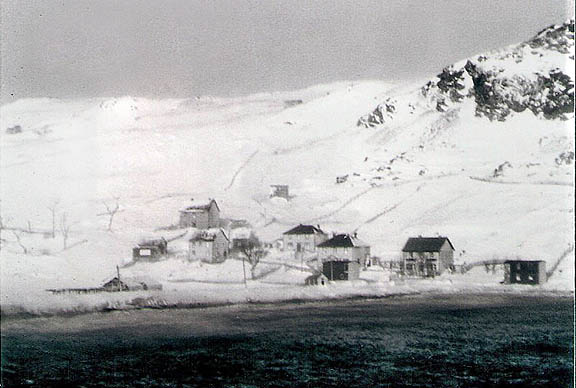 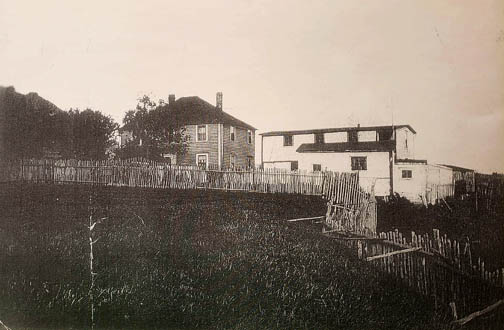 Standing under a snowy Clown's Cove Tolt, a hand full of Pike family homes stand near the ice filled waters. On the south side of the cove, the Butt and later Noel homestead stood east of the Orange Lodge and Graham Butt's home. The two story shed housed the Butt family horse drawn carriage and later Model T Ford. There was also a vegetable and fruit store (storage building) located on their property. (Photos from Public Facebook group - Freshwater, C.B., Newfoundland) |
  With a few small boats in the cove, a 1948 aerial image shows Clown's Cove and surrounding community with the large school building at the far right of the photo. A winter view of Clown's Cove Tolt in 1959 shows the Pike family homes clustered in the distance on the right side of the photo and homes off the Main Road east of Parsons Lane in the center and left side. (Photos from Public Facebook group - Freshwater, C.B., Newfoundland) |
 Useful for storing vegetables and canned foods, a few underground storage cellars remain in various states of preservation in Freshwater and Clown's Cove. One resident commented about visiting a cellar "I remember going there with my mom to get vegetables they stored away for the winter." The cellar photographed in the middle was on the Rueben Pike family property and the photograph on the right was near the property of one of the many Parsons families. (Photos from Public Facebook group - Freshwater, C.B., Newfoundland) |
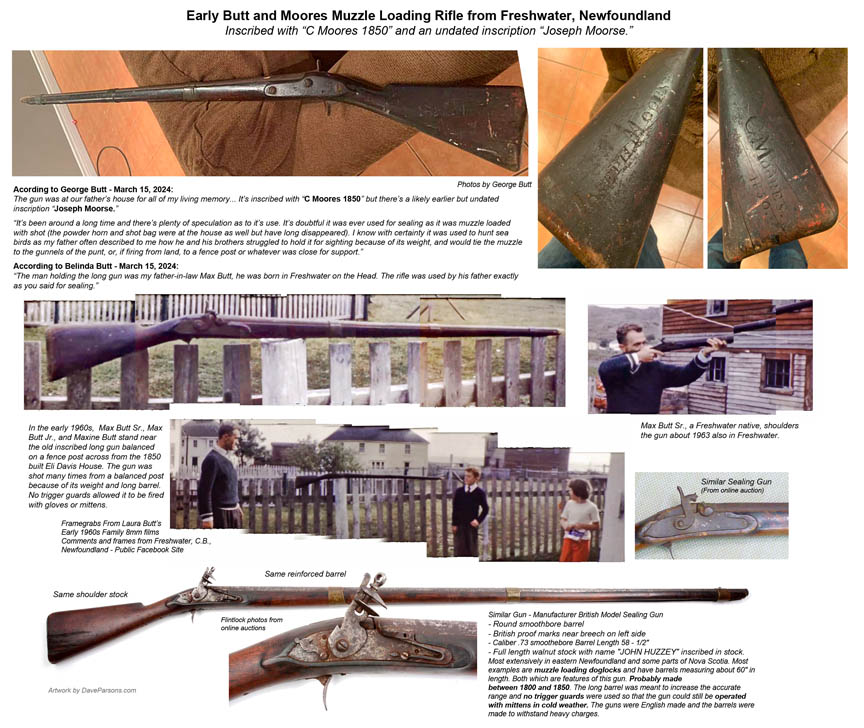 An amazing piece of early Clown's Cove / Freshwater history, a muzzle loaded long rifle inscribed with "C MOORES 1850" and "JOSEPH MOORSE" on the shoulder stock. The gun was likely a British made sealing rifle without trigger guards, allowing it to be fired with gloves or mittens. According to George Butt: "It's been around a long time and there’s plenty of speculation as to it’s use. It’s doubtful it was ever used for sealing as it was muzzle loaded with shot (the powder horn and shot bag were at the house as well but have long disappeared). I know with certainty it was used to hunt sea birds as my father often described to me how he and his brothers struggled to hold it for sighting because of its weight, and would tie the muzzle to the gunnels of the punt, or, if firing from land, to a fence post or whatever was close for support." Another family member, Belinda Butt comments "The man holding the long gun was my father-in-law, he was born in Freshwater on the Head. The rifle was used by his father exactly as you said, for sealing." (Photos and comments from Public Facebook group - Freshwater, C.B., Newfoundland) |
  Early 1960s life in Clown's Cove and Freshwater is captured in frame grabs from old 8mm films of the Butt and Davis families, from harvesting potatoes to going out on a partridge hunting party in the barrens along the Witless Bay Line (later the Trans Canada Highway). (Photos from Public Facebook group - Freshwater, C.B., Newfoundland) |
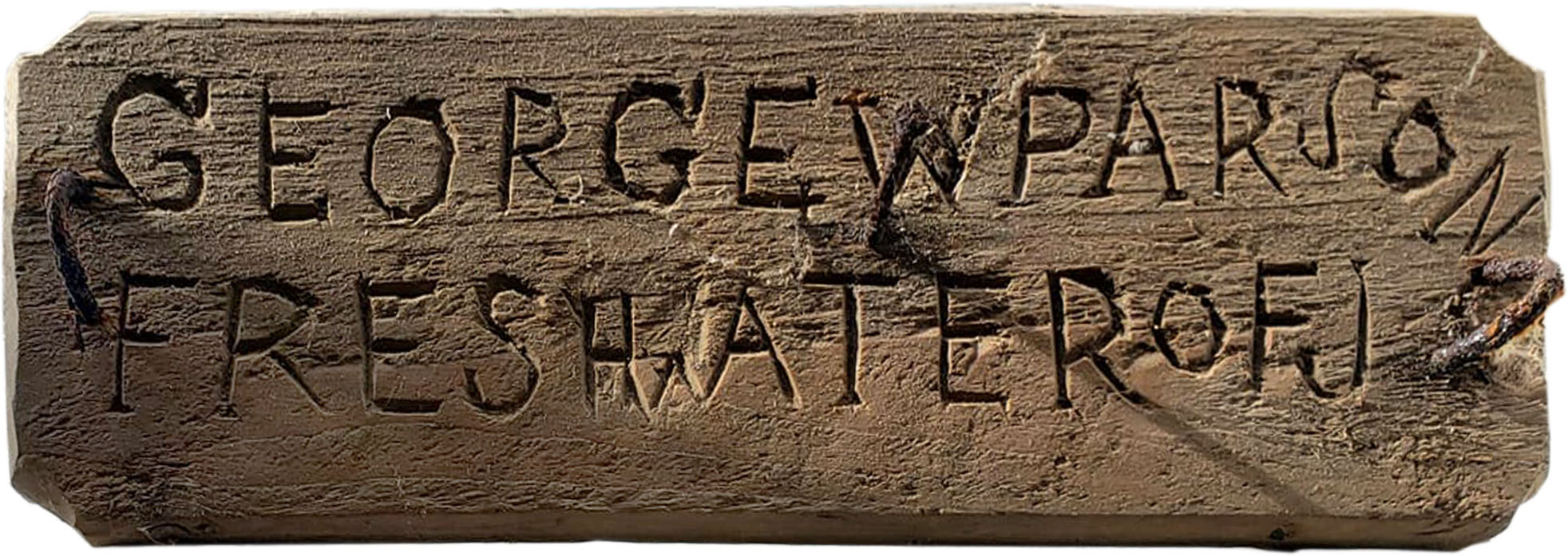 Carved into a small piece of wood, "GEORGE W PARSON - FRESHWATER OF J". There was a George William Parsons born in nearby Otterbury October 4, 1891, with his grave in Freshwater dated September 14, 1947. His father was James Henry Parsons, who was also born in Otterbury on March 23, 1861. In addition, George W. Parsons was listed on the donations page for the 1906-7 Freshwater Circuit subscription for ministers salary. (Photos from Public Facebook group - Freshwater, C.B., Newfoundland) |
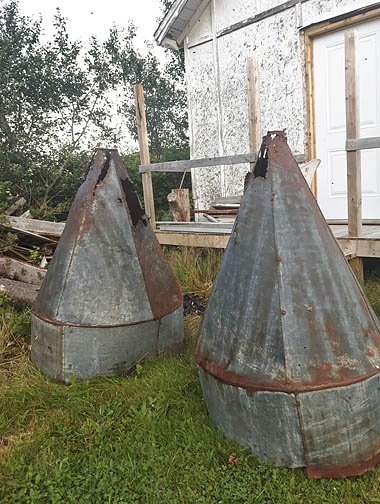  Still standing, a couple of early, overturned 1910s galvanized steel funnels from a Clown's Cove cod liver oil factory remain in a yard of a Freshwater resident, held together with rusted bolts (sadly disposed of in 2018). On a weathered piece of paper, residents of Flatrock, Blow Me Down, Freshwater and Clown's Cove are listed on a donations page for the 1906-7 Freshwater Circuit subscription for ministers salary. (Photos from Public Facebook group - Freshwater, C.B., Newfoundland) |
 An interesting Newfoundland - Freshwater superstition - My great grandmother Bertha Davis Parsons took a photo of W. J. Moore's coal shed with "good luck" circles painted on the doors. The 1947 magazine page, Around Newfoundland with a camera : a pictorial souvenir of the crossroads of the Atlantic is from the Memorial University of Newfoundland. Freshwater also had it's share of superstitions and folklore. According to one resident, the sound of drummers would travel across the water on foggy nights. The drummers played as a doomed ship and its crew sank beneath the waves out in the sound. "The drummers - terrifying things they were - playing the drums while the ship and all went down.....You could hear them sometimes - but only on foggy nights....I think that's why people called the sound - the Sound. Ma used to say there were a lot of ghosts in Freshwater." Another resident wrote "My Grandmother Butt hears the drums first when she moved to Freshwater. She had never heard about them and became very upset because she thought there was a boat in trouble. Then my grandfather had to tell her the story. Great story!" (Freshwater Facebook posts)
In addition, more than 7,000 wrecks line the coast of Newfoundland. Other locals had family members hear the drums, and one long time resident, Ted Noel, who built his house in Carbonear in 1945, mentions the "Legend of the Hollies" where the sound of groaning shipwrecks and voices from the past drift off the water. (Memorial University of Newfoundland interview) There was the fear of rock slides from the nearby tolt and the childhood fear of the neighbors dark cellars as they passed by during the night time hours. "My biggest fear was going up Plank Lane and passing Feltham's cellar, it was haunted, you know.....seems silly now. But, even now when I walk up Plank Lane, I still look to where the cellar used to be." (Freshwater Facebook post) Wandering cows and horses during the night also spooked many residents as "they roamed back then and you could trip over them in the dark. They would sleep in the middle of road. I was terrified of them, even though my father always owned a horse and I too have had nightmares about them." (Freshwater Facebook post) |
 Boats were the key to survival in Newfoundland outports, whether it was a small fishing punt full of fish or the banking schooner delivering people and packages from close and distant ports. Busy with activity, fishermen, residents, sailors, passengers and dock workers shuffle supplies and goods on the Freshwater Cove wharf about 1900. Maiden Island and a distant Carbonear Island float in the background of Conception Bay. Fisherman's boats bounce in light rippling waves as a stiff breeze blows the British flag atop the mainmast of the "Belle of the Bay," a fishing schooner transferring people and cargo on the clear day. Bulky wooden barrels, likely filled with cod liver oil or perhaps flour would be rolled to and from the ship as intermingling voices, with the sound of boots and dropped boxes thumping on the weathered wharf and the clanking of rigging would echo through the air filled with the smell of the ocean and cod fish. The 39 ton ship built in 1899 in Exploits, Newfoundland was owned by a trader and dealer, Thomas Windsor. She lasted through 20 years of annual fishing off the coast of Labrador and survived a close call in 1912 where in high seas she hit projecting rocks and sheered away the masthead iron. Eventually, in 1920 she broke up near Cape Broyle, Newfoundland. (Photo from Memorial University of NFLD Maritime History Archive) |
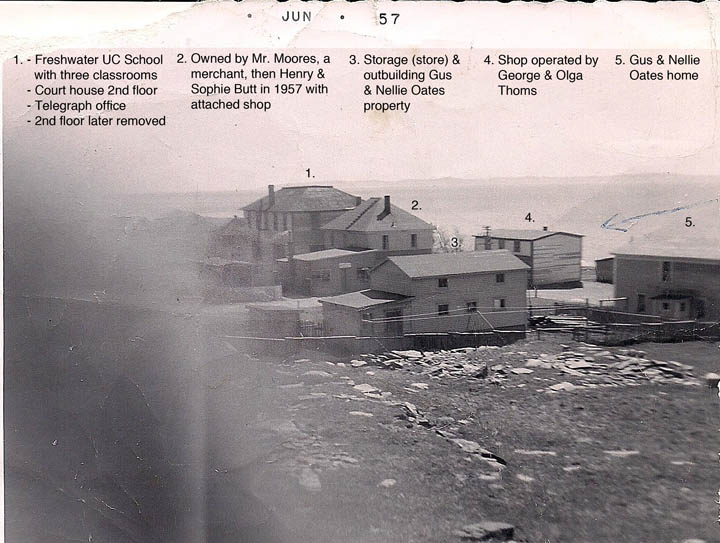 Looking southeast over Conception Bay, the above photo was taken in June, 1957. The largest, two story building left of center was the three room Freshwater UC (United Church) School with a courthouse on the second floor as well as the telegraph office in the early days. The two story home and shop right next door was initially owned by a merchant, Mr. Moores and later, in 1957 by Henry and Sophie Butt with the attached, small one story shop with the smoking chimney pipe which remained in business into the mid 1960s. George Thoms shop was across the street and outlasted Butt's shop. Gus Oates home was on the far right with their shed or barn-like storage building, many times referred to as a "store" by Newfoundlanders and nearby outbuilding on their property behind the house. The store, would be used many times for prepared fish or fishing gear including nets and cod traps. Some of Freshwater's school teachers during the years 1951 to 1958, were Miss Snow (kindergarten - 1st grade) Jean Howell, Shirley Somers, Emmie Morey (4th grade), Emily Humby (5th grade), Clayton Peach, William (Bill) Butt (who was born under the Clown’s Cove Tolt), Evan Hefford (7th grade) and John Davis (8th grade). There were three classrooms overseen by Principal Mr. Boyd Trask and followed by Mr. Clayton Peach, who remained there until the new UC Regional High School opened in Carbonear in 1960, where grades 9 through 11 attended the school initially and where students were bused to from Freshwater. The old Freshwater UC School students attended primer (transitional year between kindergarten and 1st grade) through grade 11 classes. (Photo from public Facebook group Freshwater, C.B.,Newfoundland) |
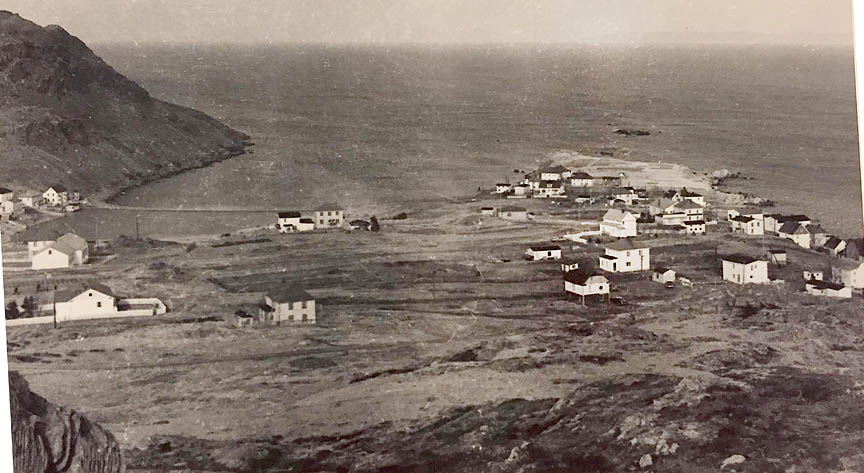 Looking over a rather desolate Clown's Cove Head, the above photo was taken about 1965. The Orange Lodge built in 1911 stands almost hidden on the far right. The school lost its second story and no stages or sheds stand on the cove. The Eli Davis house stood far out on the head. The population of Freshwater was at or almost at its lowest point in history. According to the 1971 Census, the Freshwater population was 147 people. (Photo from public Facebook group Freshwater, C.B.,Newfoundland) |
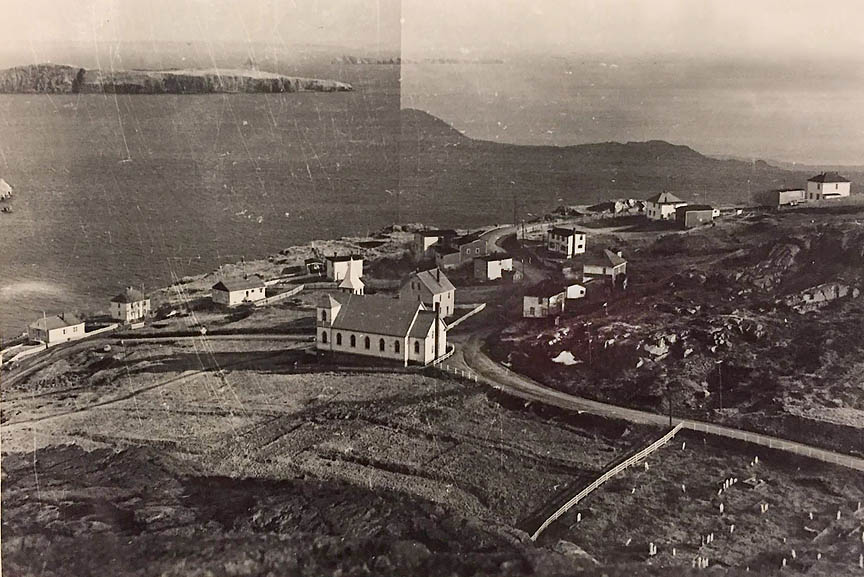 In a double exposure taken about 1965, the Freshwater United Church, built in 1926 and the cemetery stands on the high ground. Carbonear Island stands in the distance. Homes line the coast of Freshwater Cove at the base of Church Hill and climb the rocky Freshwater Tolt. (Photo from public Facebook group Freshwater, C.B.,Newfoundland) |
|
|
|
Further preserving the names and history of Freshwater, The Merchants of Freshwater There’s a little town in Conception Bay Reuben and Jake Parsons had a Cod Liver Oil Factory Further up the road Walter Pike would sell coal for 100 weight a Buck Freeman and Reg Noel had a Sawmill, a little further on Ralph Noel had a Turkey farm. Where he raised Turkeys for a living. Joe and William Noel ran a Bus and Taxi service from here. At the foot of the pond, Jack Broderick ran a The Church kept a Parsonage for the Minister to stay. The undertakers stood at the to of the hill. Now, over the cove Minnie Bowers ran the Post Office. Wallace Snow took care of the towns sanitation Now the place that’s called Plank Lane today, There were a good many Shopkeepers in the day and time Many years later a few small stores reappeared My son, Paul had a small shop All these Stores are closed now, Freshwater will always be a special place to me Herman Butt |
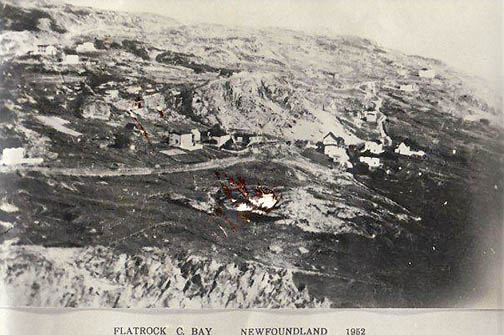 The small community of Flatrock in 1952 just east of Clown's Cove and Herman Butt's home town. (Public Facebook group - Freshwater, C.B. Newfoundland) |
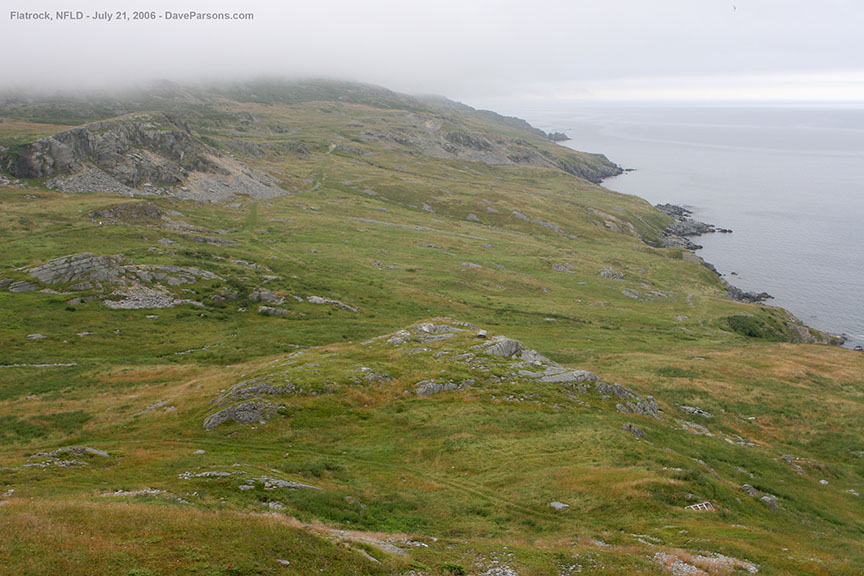 In July of 2006, only overgrown tracks and a few boards remain of the community that was once Flatrock, adjacent to Clown's Cove. The foggy view was photographed from the top of Clown's Cove Tolt looking east. Many of the homes were nestled around the cliffs in the upper left of the photograph. (Dave Parsons photo) |
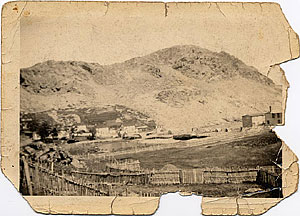 The well worn photo is taken close to where the Davis family lived on Main Road in Clown's Cove, Newfoundland. The steep hills or Clown's Cove Tolt stand north of the cove and have a path running up and over to the small village of "Flat Rock." The little pond below the homes would dry up during the summer months. Fish tie ups are on the right of the photo along the shore behind more homes. |
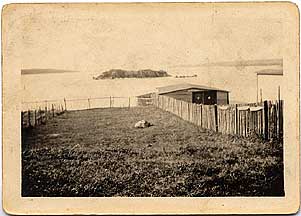 This photo is looking south towards Maiden or Maidenaire Island. Carbonear Island is on the left horizon and on the right horizon is Mosquito Point. The buildings belonged to W. J. Moores - the low one on the left is a coal shed and other was for their fish storage. The rock in the center of the photo still remains to this day just off Clements Road. |
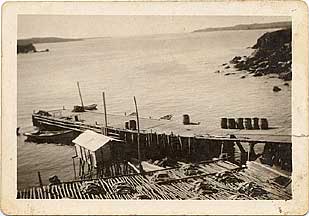 Again just off Main Road, looking south-west at the long wharf with fish stages. In the foreground, bundles or piles of fish are stacked ready to be spread out and dried on the stage overlooking the waters of Freshwater Cove. |
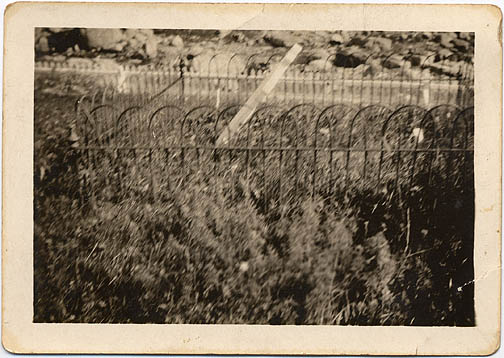 Hand forged, wrought iron cemetery plot fence stands just north of the church. It was most likely made by a family member and important enough to photograph in 1929 by Bertha Davis Parsons. |
 Bertha Davis Parsons stands near her parents home at Freshwater/Clown's Cove just off Main Road. |
 James T. Parsons Jr. visiting the Davis family. |
 The historic Freshwater United Church was built in 1926 and stands in between homes in Freshwater and Clown's Cove with a fisherman's boat in the foreground. |
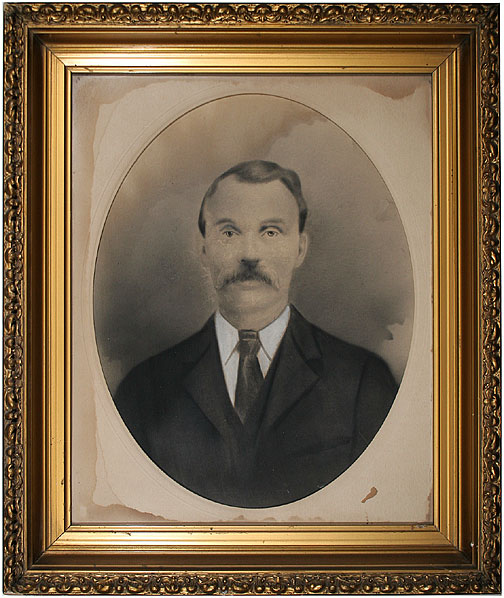 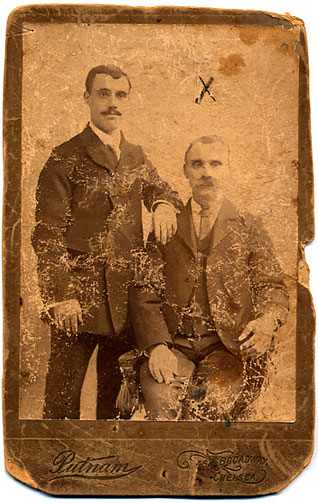 |
Long time Freshwater resident Nicholas Parsons migrated to the U.S. in 1899 with his sons where his family had a portrait drawn from a photograph. The studio photograph was taken by Putnam in Chelsea, Massachusetts about 1903 with James T. Parsons Sr. on the left and Nicholas Nichole Parsons, his father, on the right. Notice the "X" made above Nicholas by the artist marking the correct person to make the drawing of. Learn more of the Parsons and Davis families after their immigration to Massachusetts and see the Freshwater United Church and Methodist Cemetery in Freshwater, Newfoundland. Visit the nearby town of Carbonear, just west of Freshwater - a focus for employment, industry and household needs. Also, further southwest, the early town of Harbor Grace. Newfoundland History and Geneaology - Memorial University of Newfoundland, Family History Society of Newfoundland and Labrador, NLGenWeb with Records from Conception Bay North Region - Carbonear District, Canadian Research Knowledge Network, Families of Newfoundland |
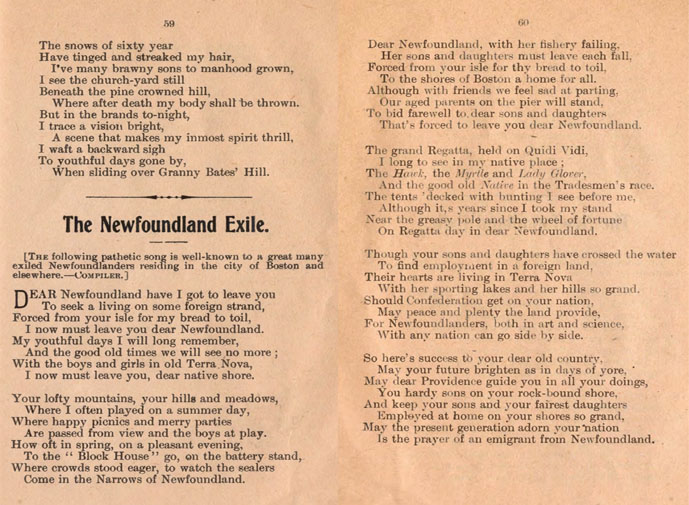 A song, perhaps encapsulating the feelings of Newfoundlanders as they traveled to Boston and abroad searching for a better life. From a 1904, Old Colony Song Book - Memorial University of Newfoundland |
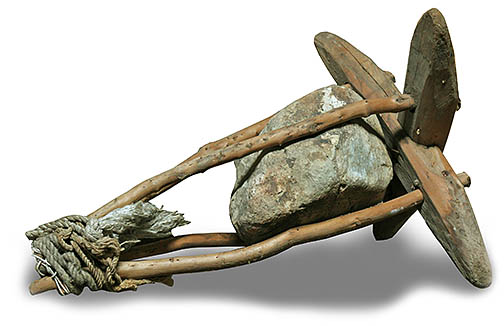 |